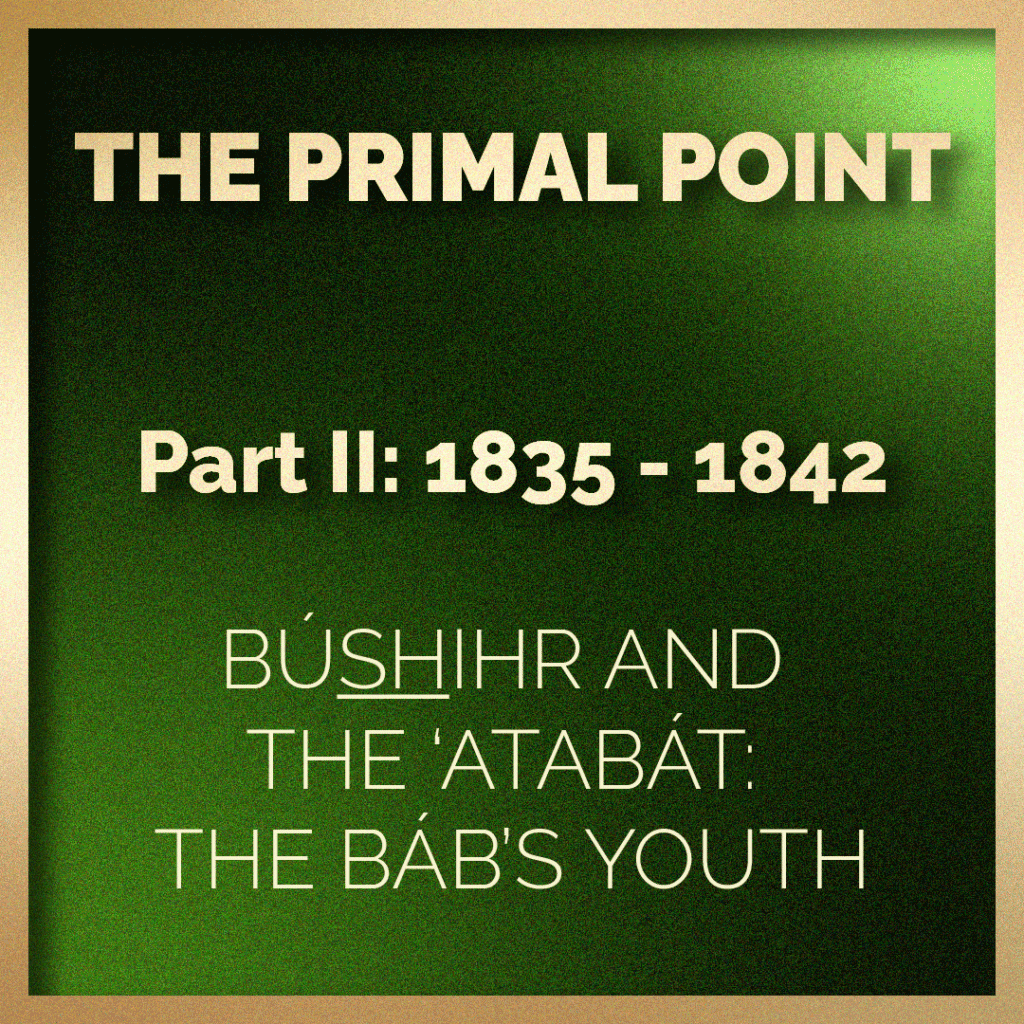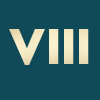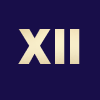
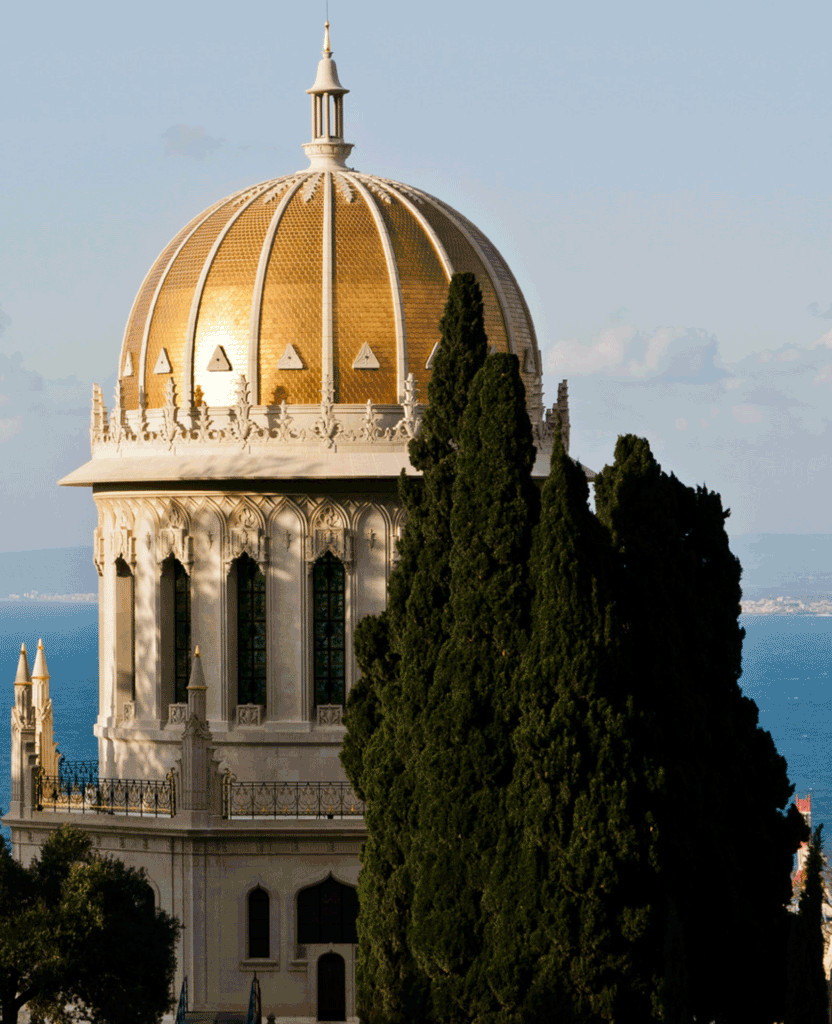
Source: Flickr.
Written and illustrated by Violetta Zein
“I am the Mystic Fane which the Hand of Omnipotence hath reared. I am the Lamp which the Finger of God hath lit within its niche and caused to shine with deathless splendor. I am the Flame of that supernal Light that glowed upon Sinai in the gladsome Spot, and lay concealed in the midst of the Burning Bush.”
Selections from the Writings of the Báb, Excerpts from the Qayyúmu’l-Asmá’, Chapter XCIV
“The substance wherewith God hath created Me is not the clay out of which others have been formed. He hath conferred upon Me that which the worldly-wise can never comprehend, nor the faithful discover.… I am one of the sustaining pillars of the Primal Word of God. Whosoever hath recognized Me hath known all that is true and right and hath attained all that is good and seemly, and whosoever hath failed to recognize Me hath turned away from all that is true and right and hath succumbed to everything evil and unseemly.”
Selections from the Writings of the Báb, Extracts from an Epistle to Muḥammad Sháh
This chronology is optimized for tablets and computers.
To read the chronology, start from the top and read down.
To navigate the chronology, move between parts with the vertical Roman numbers menu to the left of the screen, and move between sections with the numbered vertical menu to the right of the screen.
DISCLAIMER: ONLY THE BÁB’S WORDS QUOTED FROM HIS HOLY WRITINGS CAN BE CONSIDERED HIS OWN; ALL OTHER REPORTED UTTERANCES OF THE BÁB SHOULD BE VIEWED AS PILGRIM NOTES.
This part covers the life of the Báb from His birth in 1819 to the age of 15/16 in 1835.
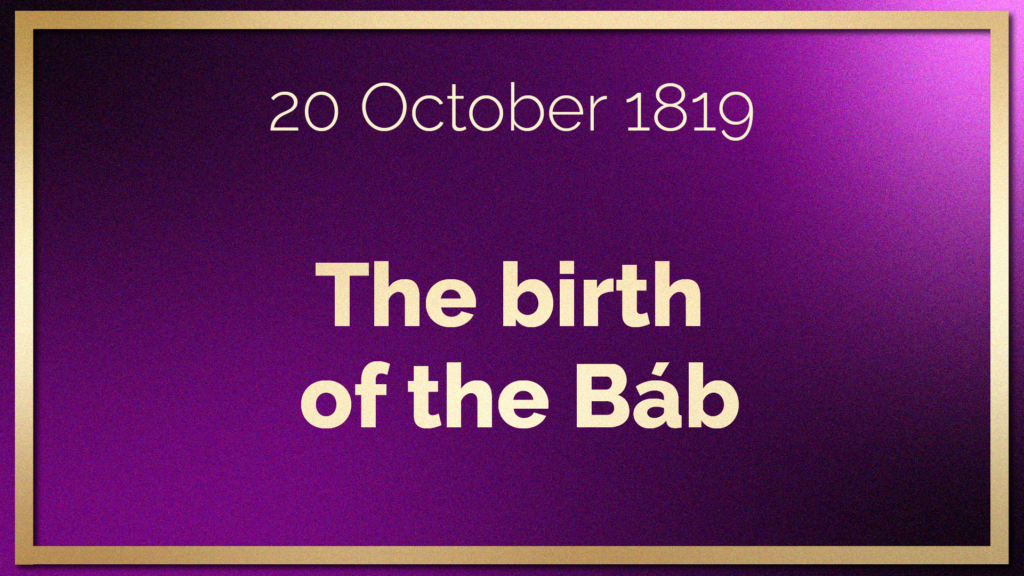
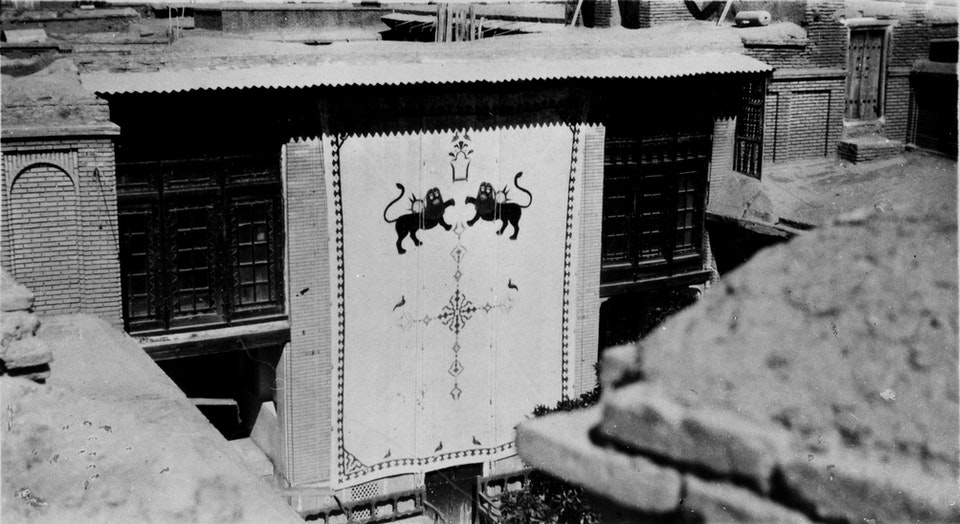
Photograph of the room where The Báb was born on 20 October 1819, in the home of His father, Siyyid Muḥammad Riḍá in Shíráz. Source: Bahá'ís of the United States: Birth of the Báb.
The day before Mírzá Ḥusayn ‘Alí Núrí celebrated His second birthday in Ṭihrán, a baby boy named Siyyid ‘Alí Muḥammad Shirází was born in Shíráz, 900 kilometers (560 miles) away from Him. These two newborn babes would later be known the world over as Bahá'u'lláh and the Báb, Manifestations of God, and founders of the Bahá'í and Bábí Faiths.
The destinies of Bahá'u'lláh and the Báb would forever be intertwined, and their lives, their words, acts, deeds, Writings, and teachings would affect deep and abiding change in the world of humanity.
The Báb belonged to a family widely renowned for its nobility and pure lineage. Through both His father and mother, the Báb’s ancestors could be traced through twelve centuries directly to the Prophet Muḥammad through His grandson, Imám Ḥusayn, the third Imám of Shí’ah Islám, who was the son of the Prophet Muḥammad’s daughter Fáṭimih.
It is interesting to note, given the deeply youthful character of the Báb’s life, cut so tragically short, that the Prophet Muḥammad had described the Imám Ḥusayn, the ancestor of the Báb along with one of his brothers as "the leaders of the youth of Paradise."
The Báb’s parents, Siyyid Muḥammad Riḍá, a local wholesale merchant dealing in cloth of Shíráz, and Fáṭimih Bagum, had lost children in infancy and the Báb was the first of their children to live.
Siyyid Muḥammad Riḍá’s home was located between the houses of two of Fáṭimih Bagum’s brothers, the Báb’s maternal uncles: the residence of Ḥájí Mírzá Siyyid ‘Alí the middle uncle, who would become the Báb’s guardian after His father’s passing, and Ḥájí Mírzá Siyyid Muḥammad, the eldest uncle.
The Báb was born in the upper chamber of His father’s home, in a room on the northwest corner of the building.
The first few years of His life were joy for His doting mother, Fáṭimih Bagum, whose days were filled with the responsibilities of motherhood.
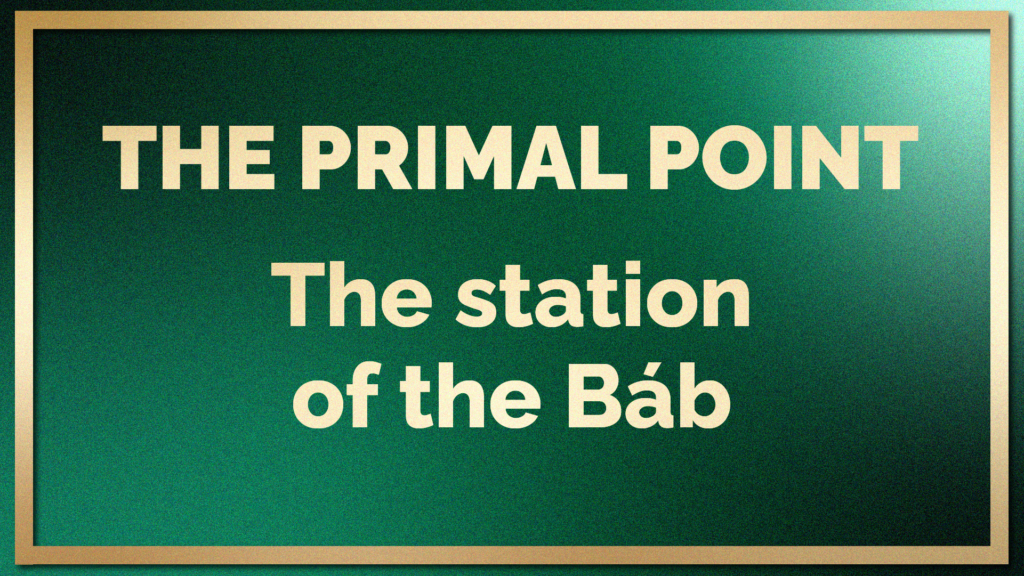

"The Primal Point": Artistic interpretation of the Station of the Báb, echoing the graphic used in The Blessed Beauty chronology Part I to illustrate the Station of Bahá'u'lláh. All the terms in the section below in bold are reproduced in the large orb in the top right corner of the artwork. © Violetta Zein
1,249 years after the birth of the last Manifestation of God, the Prophet Muḥammad, the world witnessed the birth of two Manifestations of God. Bahá'u'lláh was born in 1817 in Ṭihrán. Two years later in 1819, the Báb was born. In God Passes By, Shoghi Effendi introduces us to the station of the Báb in the following words:
He is “…the “Point round Whom the realities of the Prophets and Messengers revolve…” “whose day,” Bahá’u’lláh Himself affirms, “every Prophet hath announced,” for which “the soul of every Divine Messenger hath thirsted,” and through which “God hath proved the hearts of the entire company of His Messengers and Prophets.”
Shoghi Effendi dedicates a long section of his 21 March 1932 letter, “The Golden Age of the Cause of Bahá'u'lláh” to the Báb’s station. In it, Shoghi Effendi states emphatically and unequivocally, that the Báb can in no way be reduced to being the precursor of Bahá'u'lláh:
“That He was not merely the precursor of the Revelation of Bahá’u’lláh, that He was more than a divinely-inspired personage, that His was the station of an independent, self-sufficient Manifestation of God, is abundantly demonstrated by Himself, is affirmed in unmistakable terms by Bahá’u’lláh, and is finally attested by the Will and Testament of ‘Abdu’l-Bahá.”
In another passage in God Passes By, Shoghi Effendi continues, describing the Báb:
“the promised Qá’im (He who ariseth), the Ṣáḥibu’z-Zamán (the Lord of the Age), Who assumed the exclusive right of annulling the whole Qur’ánic Dispensation, Who styled Himself “the Primal Point from which have been generated all created things … the Countenance of God Whose splendor can never be obscured, the Light of God Whose radiance can never fade.”
In perhaps the most stunning tribute to the station of the Báb, Bahá'u'lláh Himself expands upon the unfathomable signs and tokens, the unveiling of mysteries and knowledge that accompanied the Báb’s Revelation in the Kitáb-i-Íqán:
“No understanding can grasp the nature of His Revelation, nor can any knowledge comprehend the full measure of His Faith. All sayings are dependent upon His sanction, and all things stand in need of His Cause. All else save Him are created by His command, and move and have their being through His law. He is the Revealer of the divine mysteries, and the Expounder of the hidden and ancient wisdom.”
In this same passage, Bahá'u'lláh unveils an extraordinary prophecy accomplished by the Báb, quoting the “Biḥáru’l-Anvár” or “Sea of Lights,” a respected and beloved compilation of Shí’ah traditions:
“Knowledge is twenty and seven letters. All that the Prophets have revealed are two letters thereof. No man thus far hath known more than these two letters. But when the Qá’im shall arise, He will cause the remaining twenty and five letters to be made manifest.” Consider, He hath declared Knowledge to consist of twenty and seven letters, and regarded all the Prophets, from Adam even unto the “Seal,” as Expounders of only two letters thereof and of having been sent down with these two letters. He also saith that the Qá’im will reveal all the remaining twenty and five letters. Behold from this utterance how great and lofty is His station! His rank excelleth that of all the Prophets, and His Revelation transcendeth the comprehension and understanding of all their chosen ones.”

"Morn of Truth": Artistic interpretation of the Revelation of the Báb, marking the end of the Adamic cycle, and the beginning of the bahá'í cycle. © Violetta Zein
The Báb’s life stands at the meeting point of the two great prophetic cycles bestowed by God on humanity: He signalizes the end of the Adamic cycle, which began with humanity’s recorded religious history, and announces the beginning of the Bahá'í cycle, destined to last five thousand centuries.
Unparalleled among the lives of Manifestations of God in religious history, for its intensity and for its barbaric end, the Báb’s 31 years on this earth were like a comet, searing through the darkest of nights in the sky of a broken, lost Persia, showing the way to the Revelation of Bahá'u'lláh.
It is unthinkable that a life as large as His would not be the object of unnumbered prophecies. In an attempt to guide us in our proper understanding of the station of the Báb, before we begin this journey through His unmatched, glorious life, we should place the Báb in the context of religious prophecies about His advent. The section below is entirely in the words of Shoghi Effendi from God Passes By:
The Báb, acclaimed by Bahá’u’lláh as the “Essence of Essences,” the “Sea of Seas,” the “Point round Whom the realities of the Prophets and Messengers revolve,” “from Whom God hath caused to proceed the knowledge of all that was and shall be,” Whose “rank excelleth that of all the Prophets,” and Whose “Revelation transcendeth the comprehension and understanding of all their chosen ones,” had delivered His Message and discharged His mission.
He Who was, in the words of ‘Abdu’l-Bahá, the “Morn of Truth” and “Harbinger of the Most Great Light,” Whose advent at once signalized the termination of the “Prophetic Cycle” and the inception of the “Cycle of Fulfillment,” had simultaneously through His Revelation banished the shades of night that had descended upon His country, and proclaimed the impending rise of that Incomparable Orb Whose radiance was to envelop the whole of mankind.
He, as affirmed by Himself, “the Primal Point from which have been generated all created things,” “one of the sustaining pillars of the Primal Word of God,” the “Mystic Fane,” the “Great Announcement,” the “Flame of that supernal Light that glowed upon Sinai,” the “Remembrance of God” concerning Whom “a separate Covenant hath been established with each and every Prophet” had, through His advent, at once fulfilled the promise of all ages and ushered in the consummation of all Revelations. He the “Qá’im” (He Who ariseth) promised to the Shí‘ahs, the “Mihdí” (One Who is guided) awaited by the Sunnís, the “Return of John the Baptist” expected by the Christians, the “Úshídar-Máh” referred to in the Zoroastrian scriptures, the “Return of Elijah” anticipated by the Jews, Whose Revelation was to show forth “the signs and tokens of all the Prophets”, Who was to “manifest the perfection of Moses, the radiance of Jesus and the patience of Job” had appeared, proclaimed His Cause, been mercilessly persecuted and died gloriously.
The “Second Woe,” spoken of in the Apocalypse of St. John the Divine, had, at long last, appeared, and the first of the two “Messengers,” Whose appearance had been prophesied in the Qur’án, had been sent down.
The first “Trumpet-Blast”, destined to smite the earth with extermination, announced in the latter Book, had finally been sounded.
“The Inevitable,” “The Catastrophe,” “The Resurrection,” “The Earthquake of the Last Hour,” foretold by that same Book, had all come to pass.
The “clear tokens” had been “sent down,” and the “Spirit” had “breathed,” and the “souls” had “waked up,” and the “heaven” had been “cleft,” and the “angels” had “ranged in order,” and the “stars” had been “blotted out,” and the “earth” had “cast forth her burden,” and “Paradise” had been “brought near,” and “hell” had been “made to blaze,” and the “Book” had been “set,” and the “Bridge” had been “laid out,” and the “Balance” had been “set up,” and the “mountains scattered in dust.” The “cleansing of the Sanctuary,” prophesied by Daniel and confirmed by Jesus Christ in His reference to “the abomination of desolation,” had been accomplished.
The “day whose length shall be a thousand years,” foretold by the Apostle of God in His Book, had terminated.
The “forty and two months,” during which the “Holy City,” as predicted by St. John the Divine, would be trodden under foot, had elapsed.
The “time of the end” had been ushered in, and the first of the “two Witnesses” into Whom, “after three days and a half the Spirit of Life from God” would enter, had arisen and had “ascended up to heaven in a cloud.” The “remaining twenty and five letters to be made manifest,” according to Islamic tradition, out of the “twenty and seven letters” of which Knowledge has been declared to consist, had been revealed.
The “Man Child,” mentioned in the Book of Revelation, destined to “rule all nations with a rod of iron,” had released, through His coming, the creative energies which, reinforced by the effusions of a swiftly succeeding and infinitely mightier Revelation, were to instill into the entire human race the capacity to achieve its organic unification, attain maturity and thereby reach the final stage in its age-long evolution.
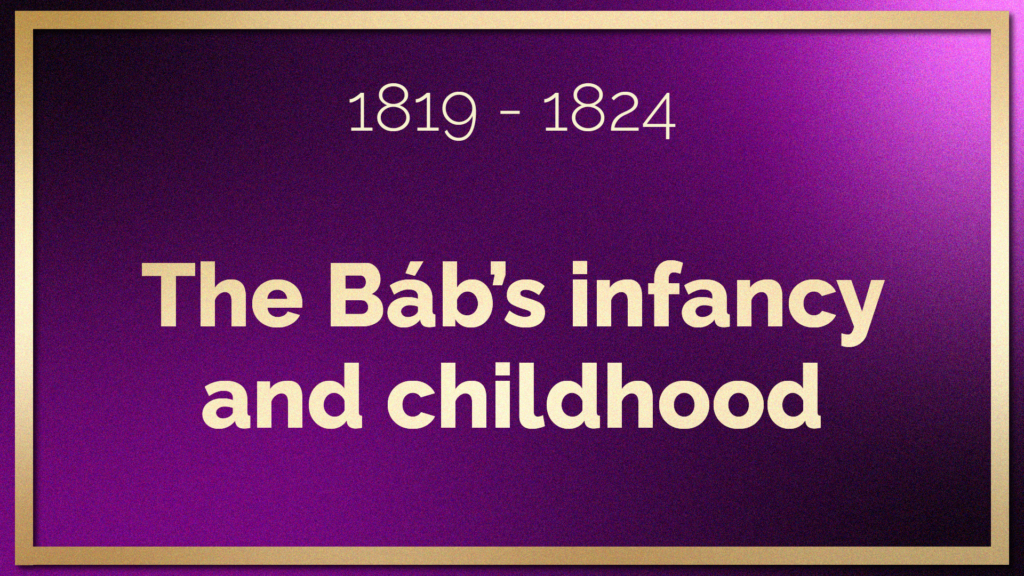
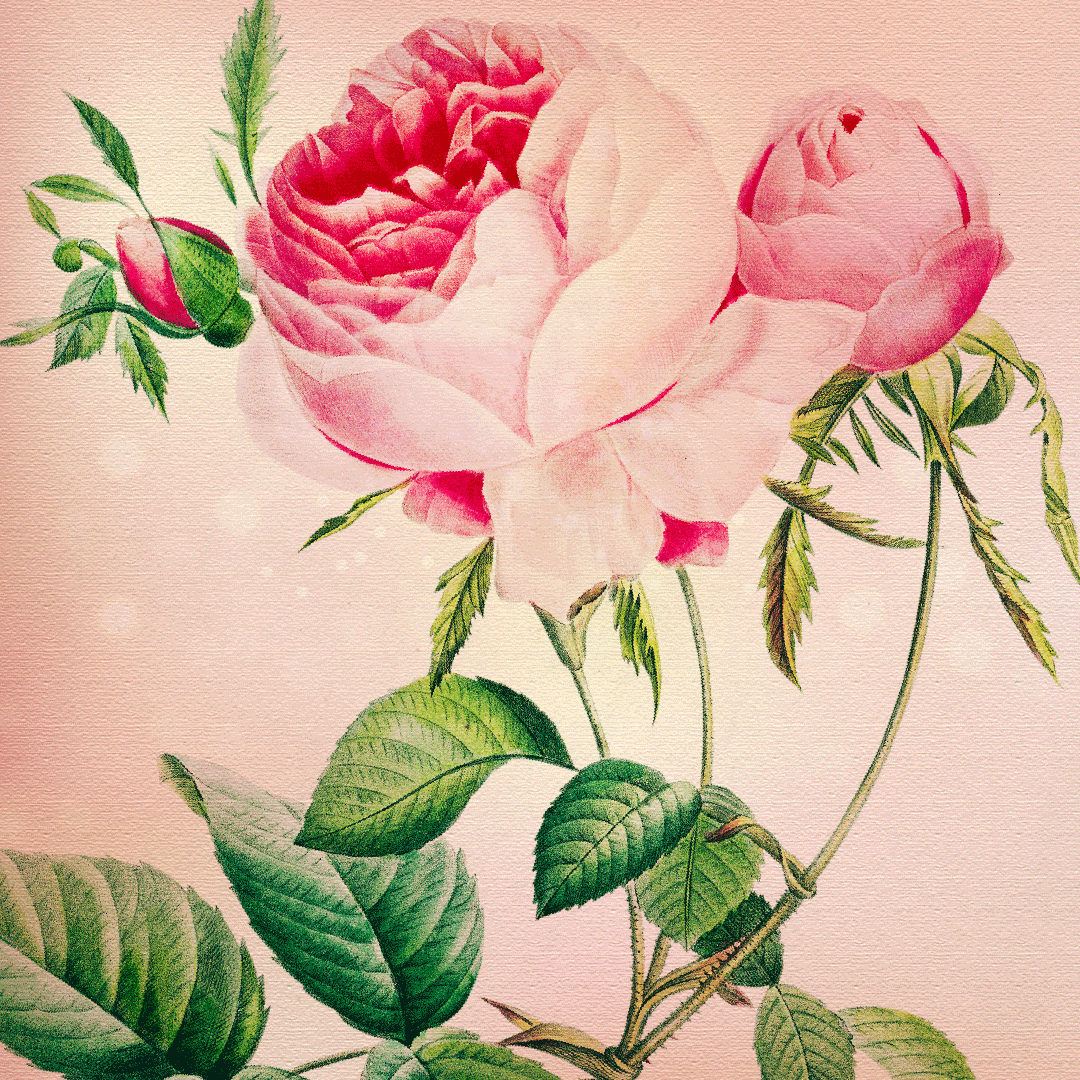
"This one Child": Artistic interpretation of the sweetness and serenity of the Báb’s first months with His loving mother. © Violetta Zein Source image: Rose watercolor illustration by Pierre-Joseph Redouté from Wikimedia Commons.
From the moment the Báb was born, he was unlike other infants, a fact that His mother, Fáṭimih Bagum often recalled. He was not a perpetually hungry, fussy, loud baby. He was always serene, never made a noise, and He suckled only four times a day, and in the most extraordinary way: He was an incredibly gentle baby, and one could not tell from His face or His mouth that he was suckling. His mother was amazed but also very preoccupied, and she became anxious, asking herself:
“Why is this Child not like other children? Perhaps He has some illness that prevents His desiring milk.”
After reflection, she reasoned her anxiety away, concluding that if the Báb did have an illness, He would be agitated and restless, not perfectly calm as He was.
Fáṭimih Bagum said that his extraordinary nature as an infant carried on through the weaning period. Most babies become difficult or throw tantrums when they stop breastfeeding, but the Báb was exemplary, and Fáṭimih Bagum would say:
“I was most thankful that now that the Exalted Lord had granted me this one Child, He was gentle and agreeable.”
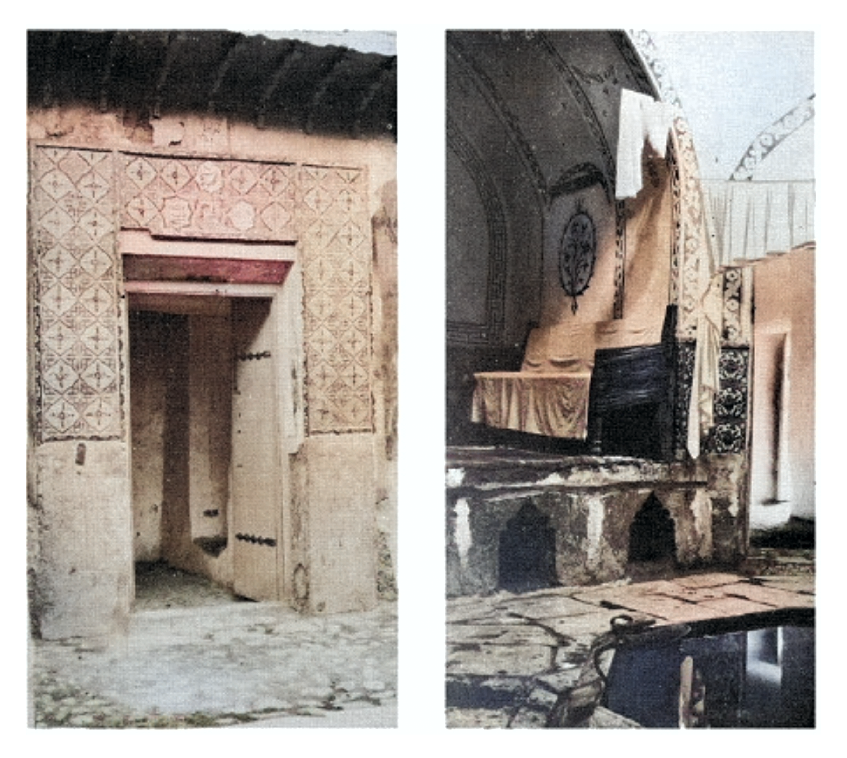
Views of the public bath in Shíráz where the Báb went as a child. Source: Nabíl, The Dawn-Breakers, page 72, colorized for this chronology by Violetta Zein.
One day, the Báb’s father and His maternal uncle Hájí Mírzá Siyyid ‘Alí, took the Báb with them to the bathhouse in the Bazaar Murgh quarter. The Báb took a nap, sleeping between His father and His uncle when He suddenly awoke and stated:
“The vaulted roof of the Garm-Khánih [steam chamber] of Mírzá Hádí’s bathhouse (a bathhouse reserved for women) has just caved in, and five women and one child have been [killed] under the rubble.”
His uncle said to Him:
“Áqá, please sleep and refrain from saying such things. What manner of talk is this!”
But the Báb simply responded,
“It is as I said.”
Shortly after, the men heard a tumult of voices coming from the women’s bathhouse saying that Mírzá Hádí’s bathhouse was wrecked and a number of women were under the rubble. Some claimed 20 women had been killed, others said 30 or even 40, but it was later determined that the actual casualties were five women and a child had been killed, exactly as the Báb had seen in His dream.

"A father marvels": Artistic interpretation of the marvel and wonderment the Báb evoked in His father as a toddler. © Violetta Zein Source for the detail from the arches of the mosque of Vakil in Shíráz: Wikimedia commons.
One day, when the Báb was around five years old, His father, Siyyid Muḥammad Riḍá, came to speak with his good friend, Shaykh 'Ábid, the Báb’s future teacher. He marveled to his friend about His Son:
“After forty years, the Exalted Lord has graced me with a Child who has caused me to wonder over His behavior.”
Shaykh 'Ábid asked his friend to explain further what he meant, but the Báb’s father only replied “It is hard to say.” The Shaykh insisted, and Siyyid Muḥammad Riḍá offered:
“O venerable Shaykh! Which of His amazing conditions should I recount? Such peculiar characteristics are manifest in Him that the people are astonished. Now, when He is five years old, He sometimes raises His hands to the threshold of the One God, and recites prayers. He wakes in the middle of the night and stands to offer His obligatory prayers, in the midst of which He weeps. Sometimes He is sad, on other occasions He is happy, or immersed in rapture, or preoccupied with the imaginary world. My astonishment and bewilderment prevents me from describing further. Were I to recount all that I have observed from the time of His birth until the present, it would make a thick book.”
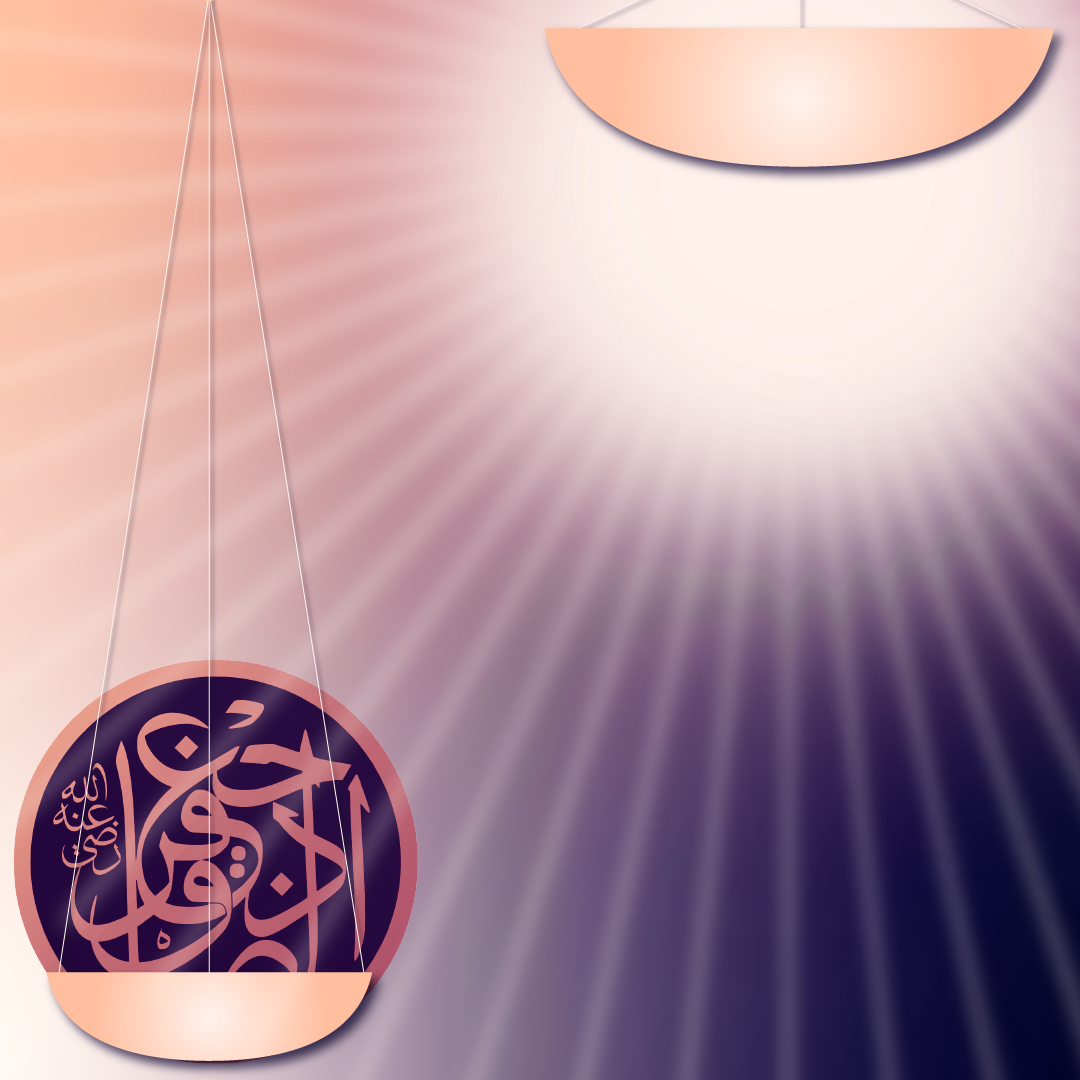
"A large balance": Artistic interpretation of the Báb’s childhood dream. © Violetta Zein Source of the calligraphy of the name of Imám Ja‘far Ṣádiq: Wikimedia Commons.
When the Báb was five years old, He dreamt a spiritual, premonitory dream about His station of prophethood, and recounted it to His family in this way:
“Last night, I dreamt that a large balance was suspended in mid-air in a vast space. Imám Ja‘far Ṣádiq was seated on one of the plates, and, because of His weight, that plate was resting on the ground while the other plate was suspended in the air. An invisible person lifted Me and placed Me on the empty plate. My plate was now heavier than the other, and I came to the ground and the first dish rose into the air.”
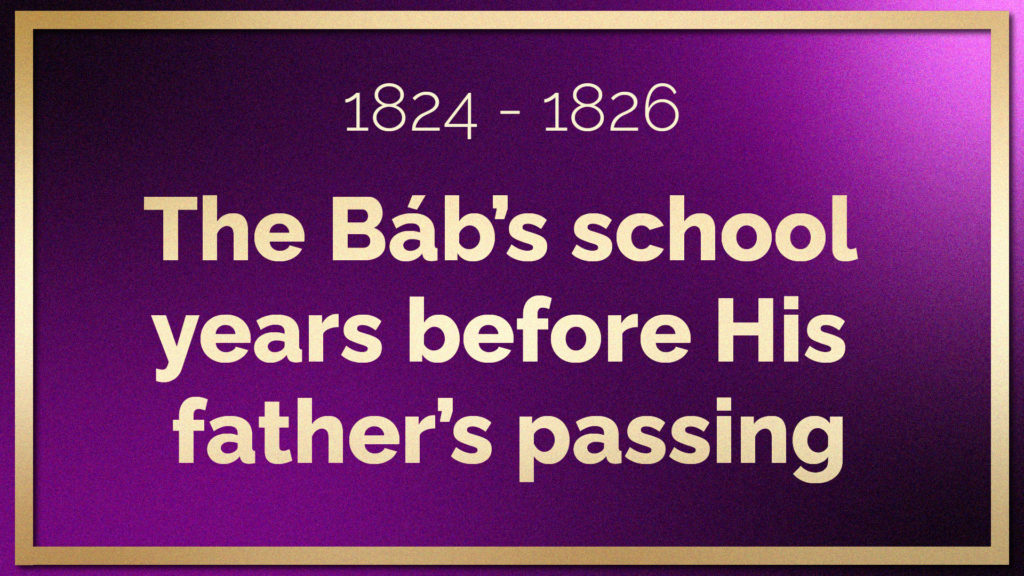
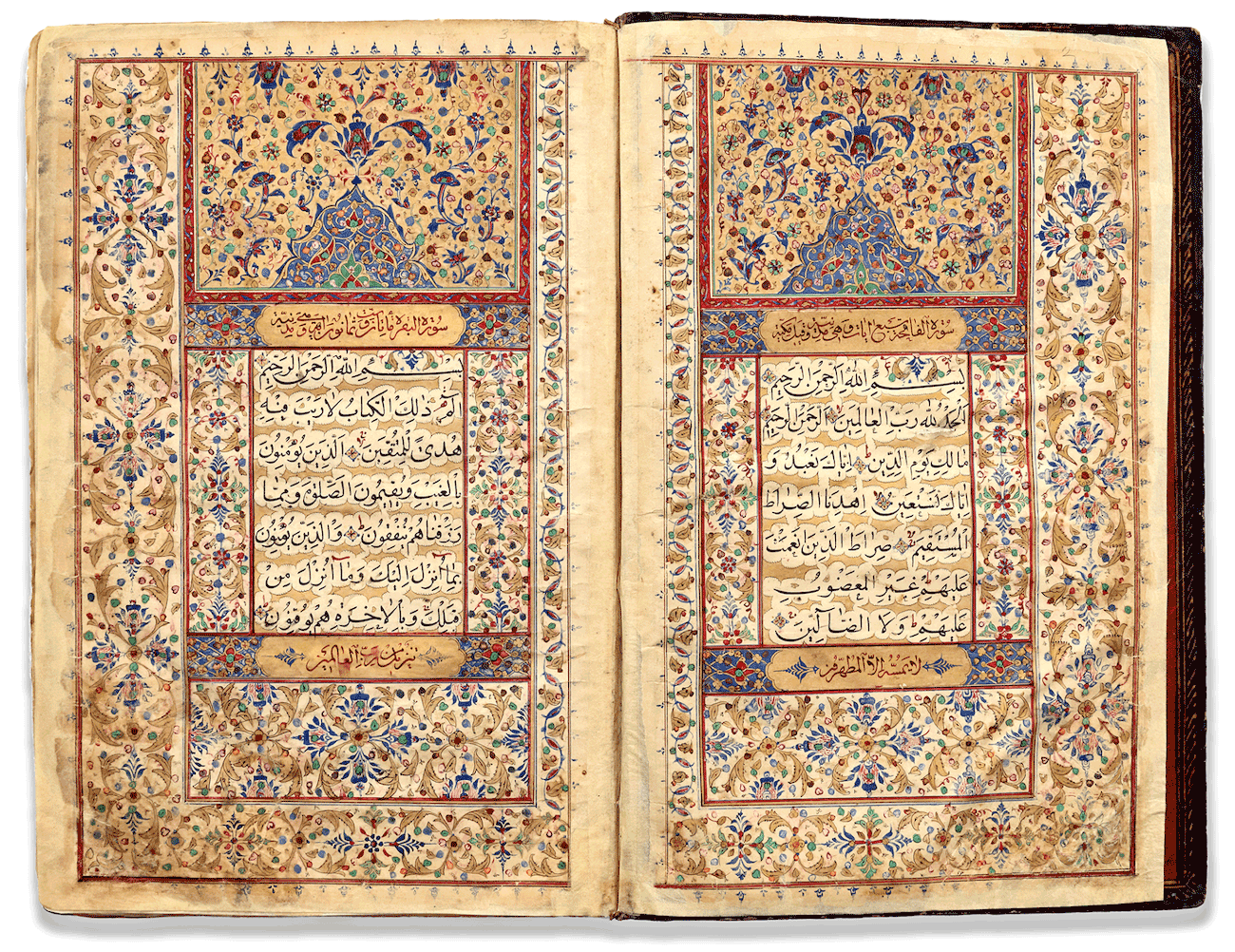
A Persian Qur’án from the 19th century. The Qur’án the Báb read from in the story below was not, in all probability, as gilded and illuminated, as this one, but this is offered as an illustration of the aesthetics of Persia in the 19th century. © Oriental Arts Auction, used with permission.
Before the Báb formally began attending Shaykh 'Ábid’s school, around the age of 5, His family agreed to introduce Him to His future teacher. Shaykh 'Ábid was a devoted Shaykhí, a follower of Shaykh Aḥmad, and his school was a well-renowned Quranic school, a Maktab, located in the Bázár-i Murgh (poultry market) of Shíráz.
It was decided that the Báb and His uncle would come to the school to meet Shaykh 'Ábid on a Thursday morning. That day, the Báb arrived, dressed in a green tunic and a cashmere skullcap.
He was followed by a servant, possibly Ḥájí Mubárak, who was carrying a small copper tray filled with sweets and with a student’s version of the Qur’án. In Shíráz at the time, it was customary for the new pupil to bring a Qur’án from which he would read.
The Báb came in, greeted everyone and sat in front of Shaykh 'Ábid, a tall, dignified man with a long beard. Soon after, His maternal uncle, Ḥájí Mírzá Siyyid ‘Alí arrived and sat next to the Shaykh. Shaykh 'Ábid took the Qur’án from the tray of sweets, opened it and asked the Báb to read. The Báb smiled, and said “As you please.”
As was the custom, Shaykh 'Ábid asked the Báb to read the verse of the Qur’án which read “He is the Deliverer, the All-Knowing.” The Báb remained silent. Shaykh 'Ábid repeated the verse, but the Báb still kept silent. The Shaykh continued to insist and finally, the Báb asked
“Who is ‘He,’ can you explain?”
The Shaykh answered
“‘He’ is God. You are still a child, and what concern of Yours is the meaning of ‘He’?”
The Báb responded:
“I am the Deliverer, the All-Knowing!”
At this point, Shaykh 'Ábid was absolutely enraged. He picked up his stick and said to the Báb:
“Do not utter such things here!”
The Báb started reading from the Qur’án, His maternal uncle smiled, made arrangements with Shaykh 'Ábid, then left.
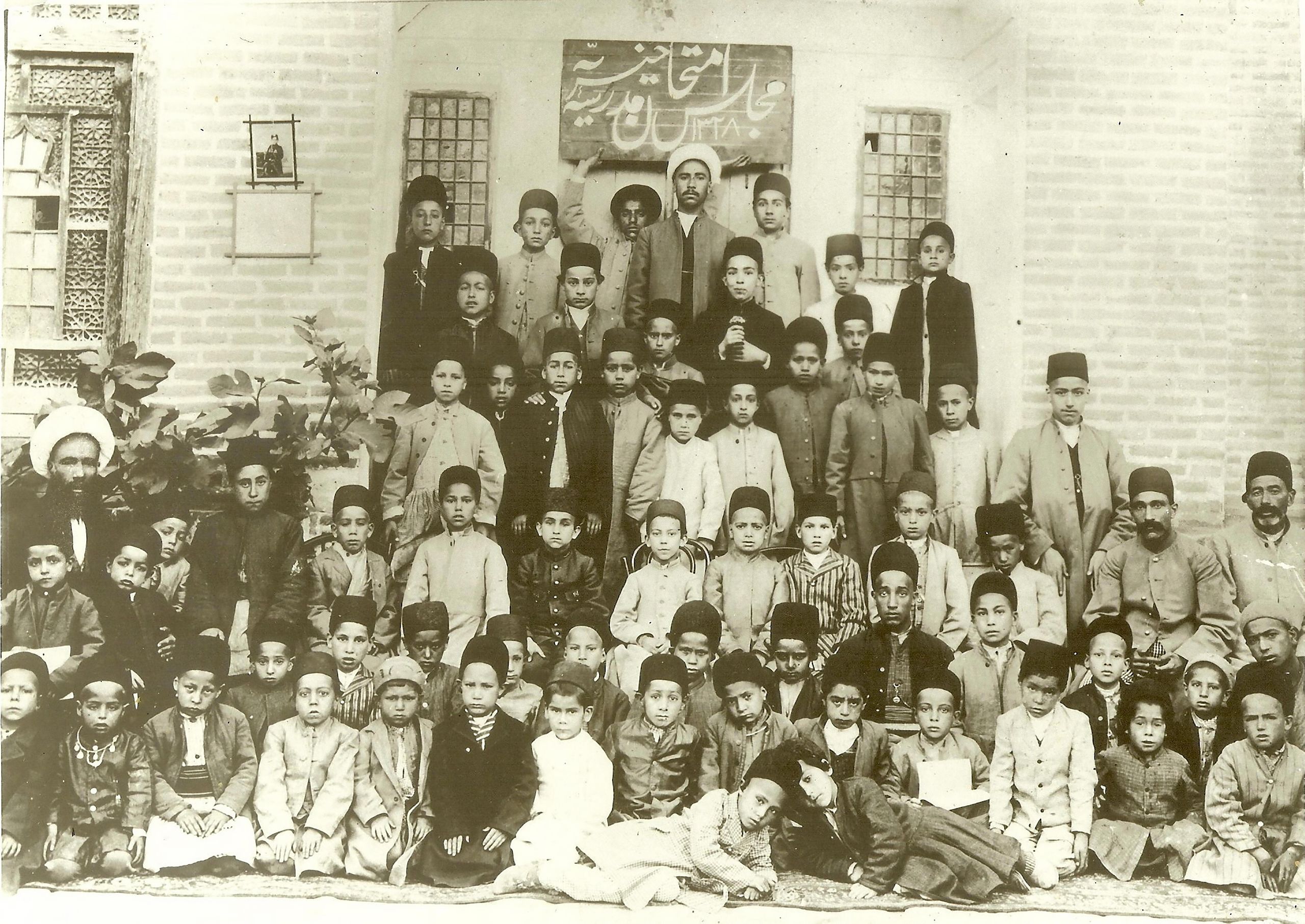
A school for boys in Urúmíyyih, Persia in 1910. Source: Wikimedia Commons.
The first day the Báb arrived at school, Shaykh had written down the alphabet for Him to learn, something he usually did with all new pupils. Shaykh 'Ábid left the school on business and returned some time later only to hear a sweet, plaintive voice reading the Qur’án.
Astonished, he asked the schoolchildren who had been reading the Qur’án and they all pointed to the Báb and said:
“He was.”
Shaykh 'Ábid asked the Báb if He had read the Qur’án, but He remained silent. The teacher tested his amazing new student. He first opened a weighty Persian book on Shí’ah doctrine in Persian, and whichever page he opened, the Báb had no difficulty in reading.
Another incident from the Báb’s first day at school was told by one of His fellow classmates who was seven years older than Him. The Báb had taken a seat, with great courtesy, between this student and another one, also much older than Him. The Báb had bowed His head in front of His homework but would not repeat them out loud. His classmate asked Him why He wasn’t reading aloud, and just then, two boys, sitting near them recited the following verse from Ḥáfiẓ:
“From the pinnacles of Heaven they call out unto thee;
I know not what hath thee here entrapped.”
The Báb turned to His classmate and said:
“That is your answer.”
The Báb would attend Shaykh 'Ábid’s school for about 5 years, until the age of 10.
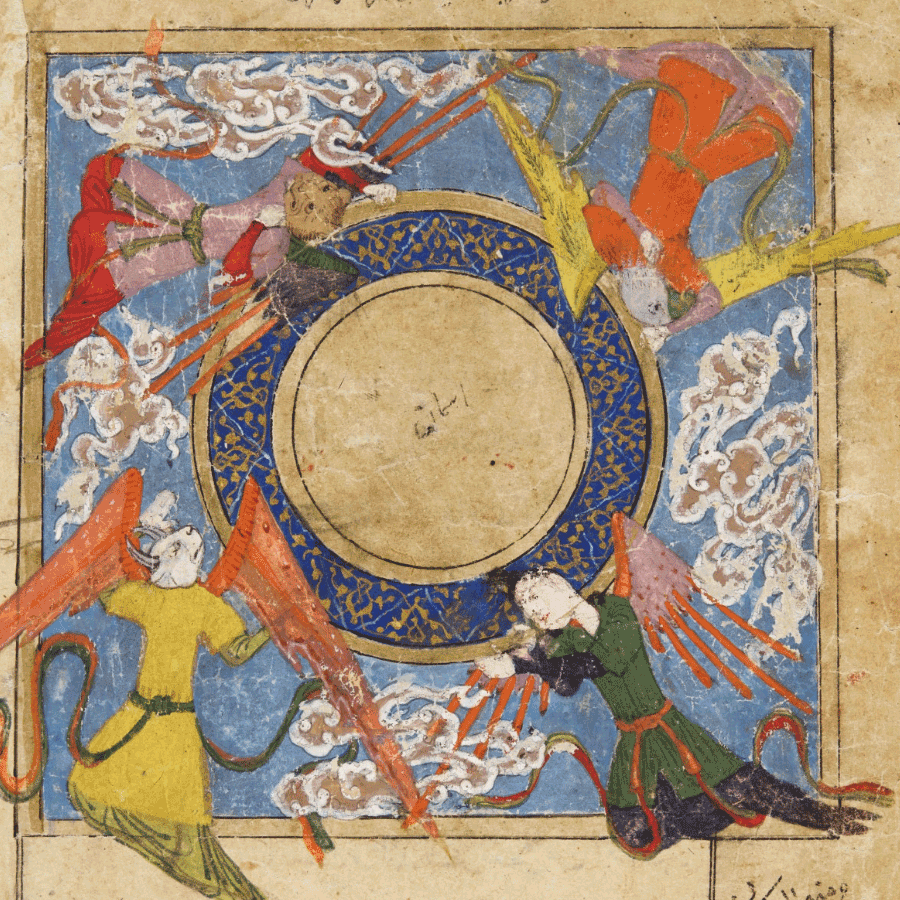
Folios from an 'Aja'ib al-Makhluqat, an illustration of four angels supporting the throne of Allah (hamlat al-'arsh), Persia, Timurid, 15th century. Source: Sothebys.
There is a very clear, documented instance, that in Bahá'u'lláh’s childhood, He had a powerful experience of prophethood, triggered by a bloody and tragic story in Islámic history, which you can read here.
Although there is no such obvious account of the experience of prophethood in the Báb’s childhood, it is abundantly clear from His early omniscience, His evident powers, His innate learning and knowledge, His extraordinary piety from the time He was a toddler, that the Báb also had direct contact with His prophethood from His earliest years.
This story is proof of His foreknowledge of His station, because it touches perhaps one of the mystical concepts of Islám, ‘Arsh, the Throne of Alláh, or the Throne of God, and before we recount the story in the Báb’s childhood, it is vital to set the concept of ‘Arsh in its proper mystical context in order to appreciate the significance of this vignette.
The Throne of God is the reigning center of God in the Abrahamic religions: primarily Judaism, Christianity, and Islam. The throne is said by various holy books to reside beyond the Seventh Heaven. In Judaism, Micaiah, Ezekiel, Zechariah, and Daniel all speak of God's throne.
In Christianity, the Throne of God is described in several forms, including the Throne of David, the Throne of Grace, a description of Heaven as the Throne of God and several more.
In Islám, the concept of the Throne of God becomes more mystical. It is not merely a place for God’s dwelling, but rather represents an elevated realm, located above the highest heaven and enveloping all the heavens and the earth, surrounding all systems, and created by God as a manifestation of His power.
In this conception, the Throne of God is a symbol of God’s power and authority, the most extraordinary and vast of all of God’s creations, a mystical creation enshrining the ultimate Glory of God.
The Throne of God is also the arena of the first manifestation of Divine will and command concerning the material and spiritual worlds, and the opposite of ‘Arsh is Farsh, ground, the material world. ‘Arsh, or the Throne of God, is the first manifestation of God Almighty’s power and grandeur, where God’s commands originate, and its utterly mysterious nature is known to God alone, as the Throne of God is a perfect mirror of all His names and attributes.
In this sense, the Throne of God would be the seat of God’s unknowable essence, a place where no mortal could ever hope to go, which makes the story below so extraordinary.
One day, Shaykh 'Ábid noticed the Báb whispering to the boy who sat next to Him, but He was silent when His teacher wanted to listen.
So Shaykh 'Ábid pretended not to pay attention to the Báb, while at the same time exerting himself to listen attentively to what He was whispering to His classmate, when he heard the Báb say:
“I am so light that, if I liked, I could fly up beyond the Throne; would you like me to go?”
And as he spoke the words “would you like me to go?” the Báb “made a movement from the ground,” which caused His teacher to smile in wonder and amazement, and as he did, the Báb suddenly stopped speaking.
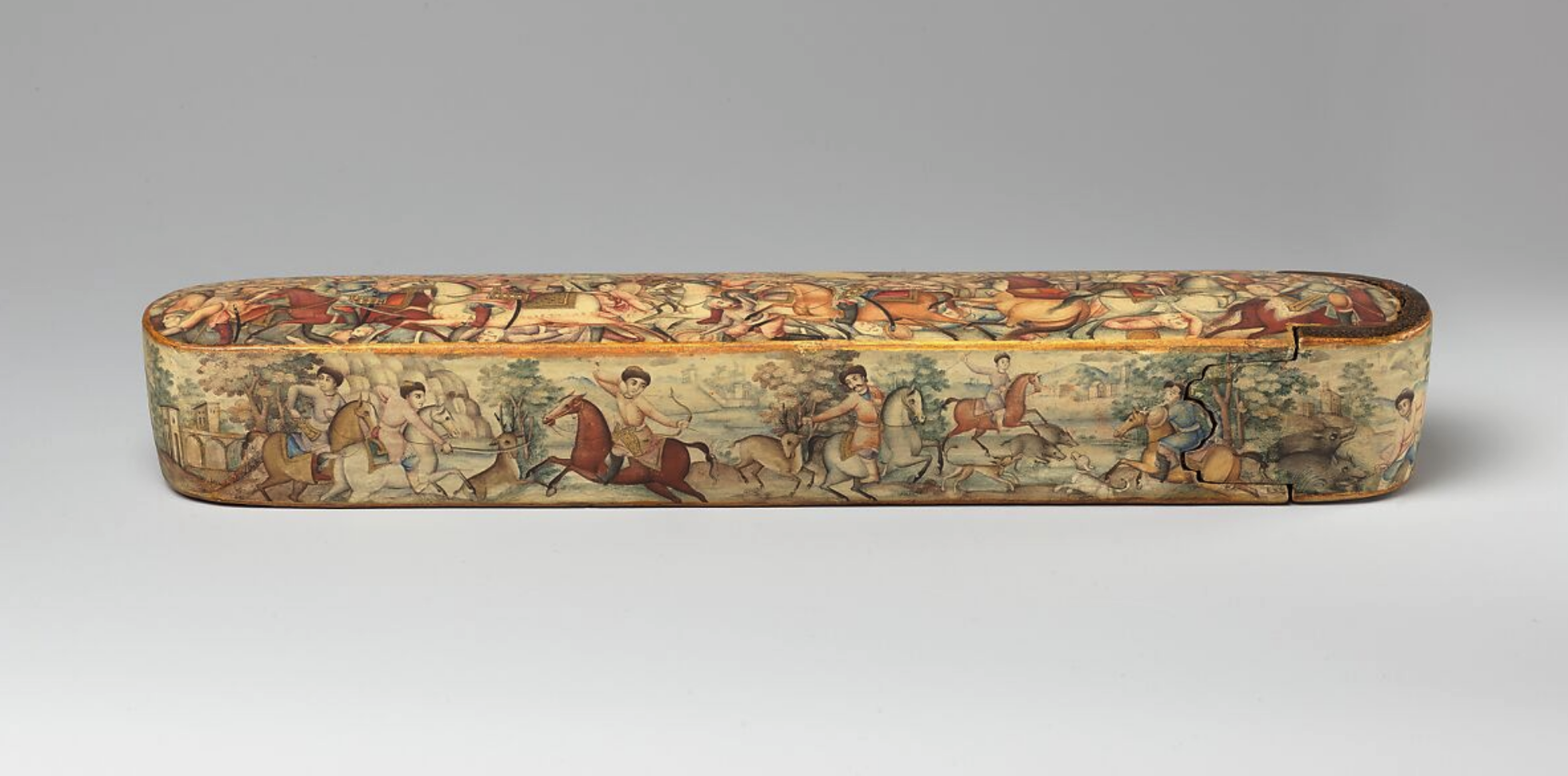
A beautiful early 19th century Persian lacquer pen case (Qalamdan) Depicting Shah Isma'il in a Battle against the Uzbeks. Source: The Met.
Every day in school, the Báb’s fellow students practiced their handwriting and calligraphy. Even though He had not yet started to learn how to write, Shaykh 'Ábid noticed that the Báb arrived at school every day with a pen case and practiced writing at the same time as the other boys.
He thought to himself,
“He sees the other boys writing, and, wishing to write too, draws lines like them, and scribbles on the paper.”
This went on for several days, and finally, Shaykh 'Ábid decided to go over and see what the Báb was scribbling.
When he looked at the sheet of paper, Shaykh 'Ábid was shocked to see that the Báb had actually written something, without having practiced, or even been taught how to write.
Even more astonishing, when he read the paper, he found that it was a dissertation on the mystery and knowledge of Divine Unity, written in the purest and most eloquent style, and so profound that the sharpest mind would not be able to seize its entire meaning.
Apparently Shaykh 'Ábid kept all these very early writings of the Báb because two Bábís, Áqá Siyyid Yaḥyá and Mullá Shaykh ‘Alí were able to see them and declared that they contained nearly 4,000 verses and that the style in which they were written was identical to the Báb’s style of Revelation after His Declaration.
Still in His childhood, the Báb wrote beautiful essays in both Persian and Arabic, and those who read them were astonished at His knowledge, as they knew He had never been formally taught Arabic. Even Arabic scholars found it extraordinary that someone who had not been taught could produce writings in such perfect Arabic.
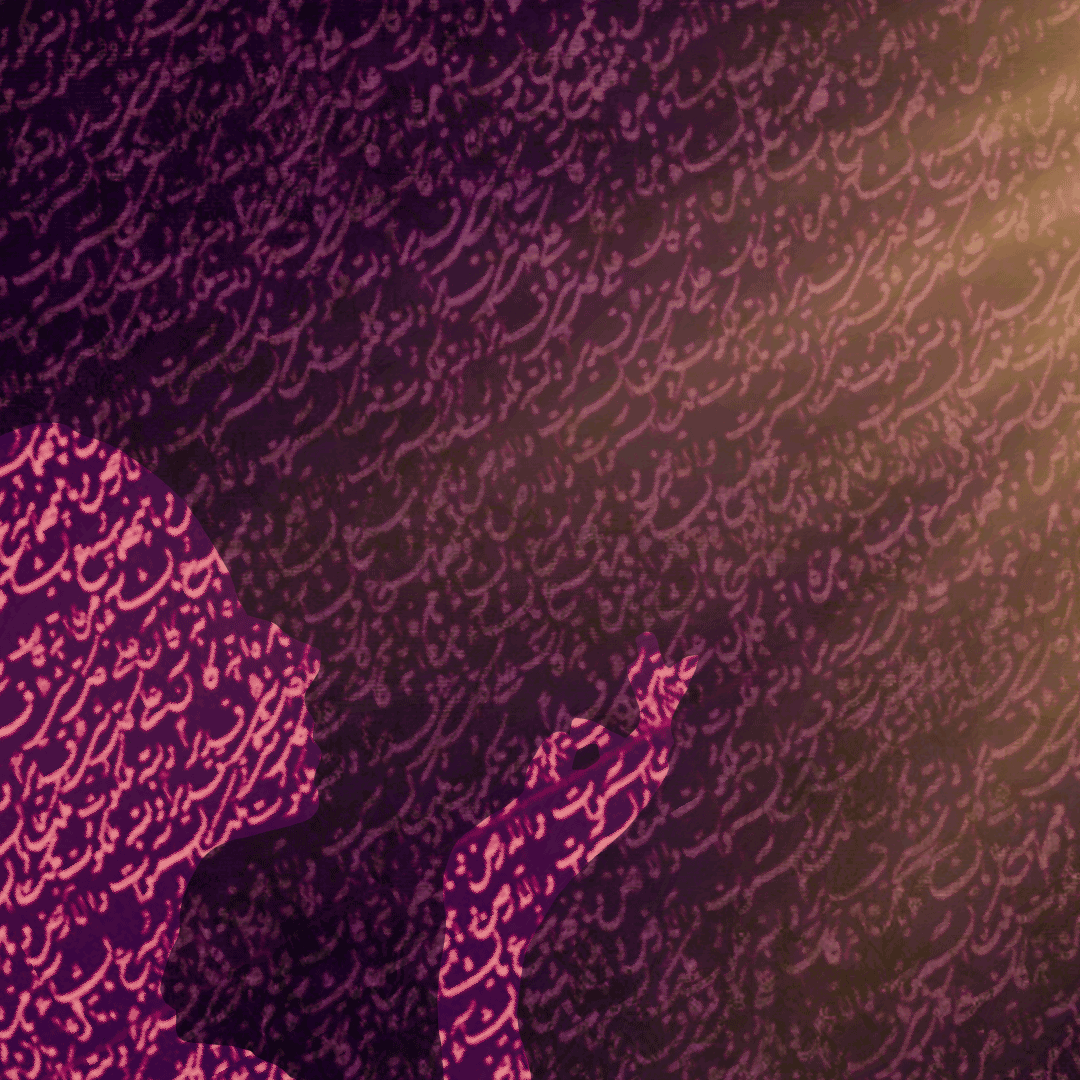
"The prayer": An artistic interpretation of the devotion of Fáṭimih Bagum, and by extension of the Báb’s entire family. The Arabic text overlaid on the digital painting is the central portion of the Báb’s haykal of invocations to God held at the British Library.
This very short vignette from the early childhood of the Báb is significant, because it shows the depth of spirituality that a Manifestation of God exhibits, so far above the human mind of a child that age, even vastly superior to any train of thought an adult may possess.
Manifestations of God, even when very young children, are astonishing creatures by virtue of the fact that their station is unknowable and that they are inseparably, constantly, at every moment connected to God and to the divine spiritual realms and inspiration while at the same time living and breathing in the material world, and among regular human beings.
When the Báb was six years old, His mother, Fáṭimih Bagum reprimanded one of the servants after she had already performed her ablutions for the sunset obligatory prayer.
The Báb said to Fáṭimih Bagum,
"Beloved Mother, would it not be well to repeat the purifying ablution before praying – that the rebuke may not tarnish thy prayer?"
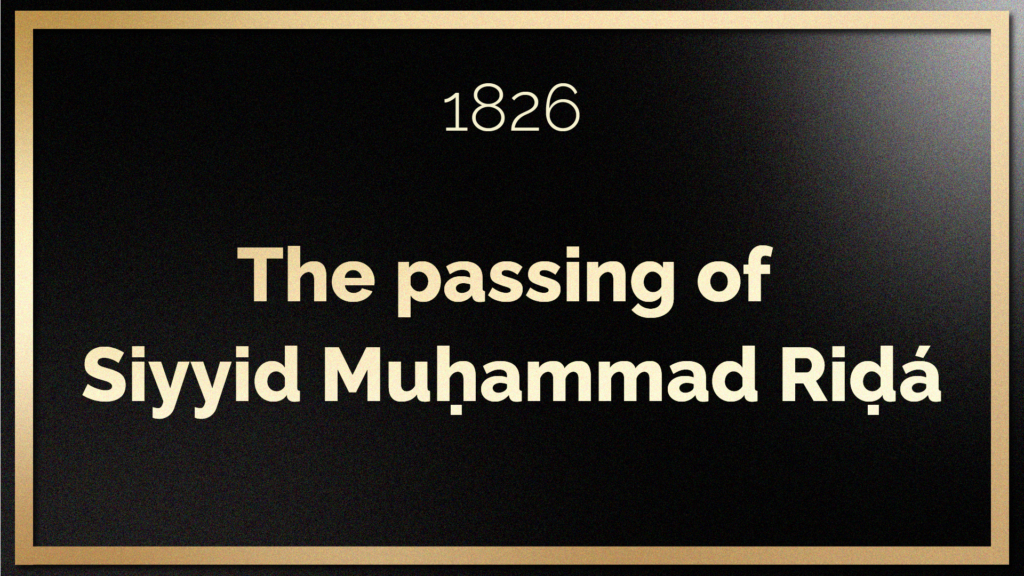
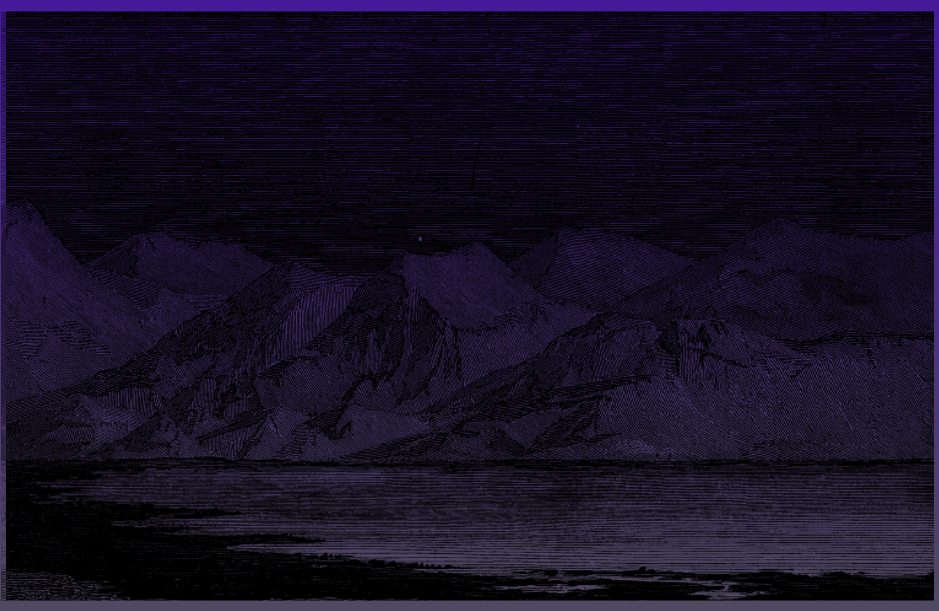
“Widow and Orphan”: An abstract homage to the lonely, desolate place that is grief, and the upended lives of Fáṭimih Bagum and the Báb when His father suddenly died. Base image, the salt lake of Maharlu just outside of Shíráz from Jane Dieulafoy, La Perse, la Chaldée et la Susiane, page 459. Source : Archive.org.
The Báb’s father, Siyyid Muḥammad Riḍá, was more of a local trader than a big merchant like his brothers-in-law (the brothers of his wife, Fáṭimih Bagum). Although he was not exceptionally prosperous, Siyyid Muḥammad Riḍá had inherited a small fortune, including a house and a shop in a trading house at the Bázár-i-Vakíl.
By marrying Fáṭimih Bagum, Siyyid Muḥammad Riḍá married into a family of big merchants (tujjár), and left enough savings to support Fáṭimih Bagum and the Báb when he died suddenly in 1826, at the age of 49, ostensibly during one of the cholera outbreaks in the province of Fars.
The Báb’s father died when He was 7 years old, and Fáṭimih Bagum’s role in the Báb’s upbringing became crucial. At the time, however, according to Islamic law, it was obligatory for a man to be the legal guardian of an orphaned minor, and so, Fáṭimih Bagum and her Son went to live with her brother, the Báb’s maternal uncle, Ḥájí Mírzá Siyyid 'Alí.
When Fáṭimih Bagum and the Báb went to live with Ḥájí Mírzá Siyyid ‘Alí, His mother’s uncle, Mírzá Siyyid ‘Alí, lived in the house next door to them, along with three of the Báb’s second cousins, a boy and two girls. One of the girls was Khadíjih Bagum, two years younger than the Báb. The two children would grow up together as playmates, and later marry.
Fáṭimih Bagum was a single mother, raising an extraordinary Child bound for an everlasting destiny and the bonds of closeness between Fáṭimih Bagum and her only child were deep.
The Báb was very close to His mother, and she played a large part in His life, but because she was a woman, our history lacks detail on her role in the Báb’s upbringing.
The Báb testified about her important role in His early life in Chapter 28 of the Qayyúm-i-Asmá,’ revealed in May/June 1844, about her important role in His life:
“O thou Mother of the Remembrance! May the peace and salutation of God rest upon thee. Indeed thou hast endured patiently in Him Who is the sublime Self of God.”
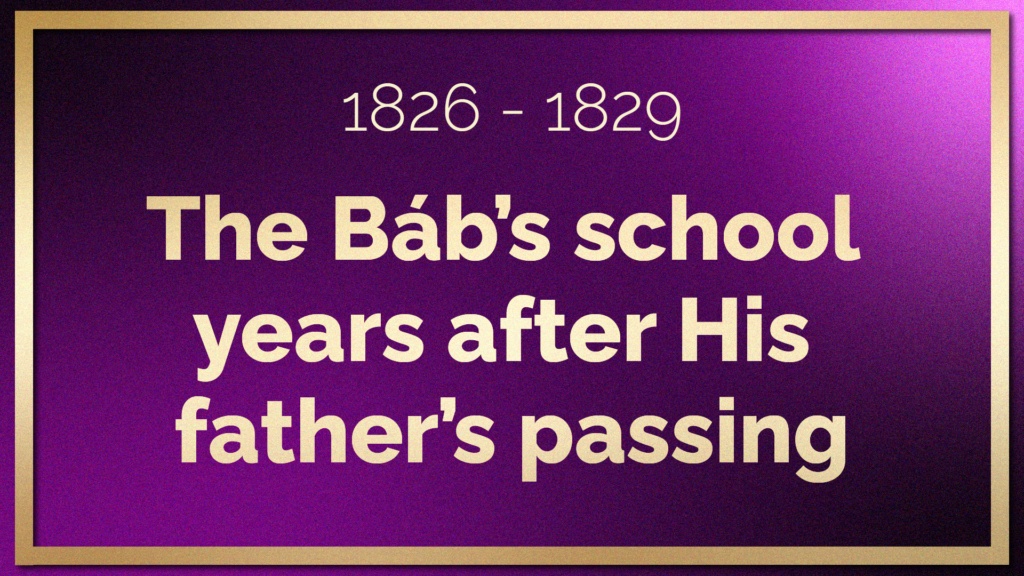
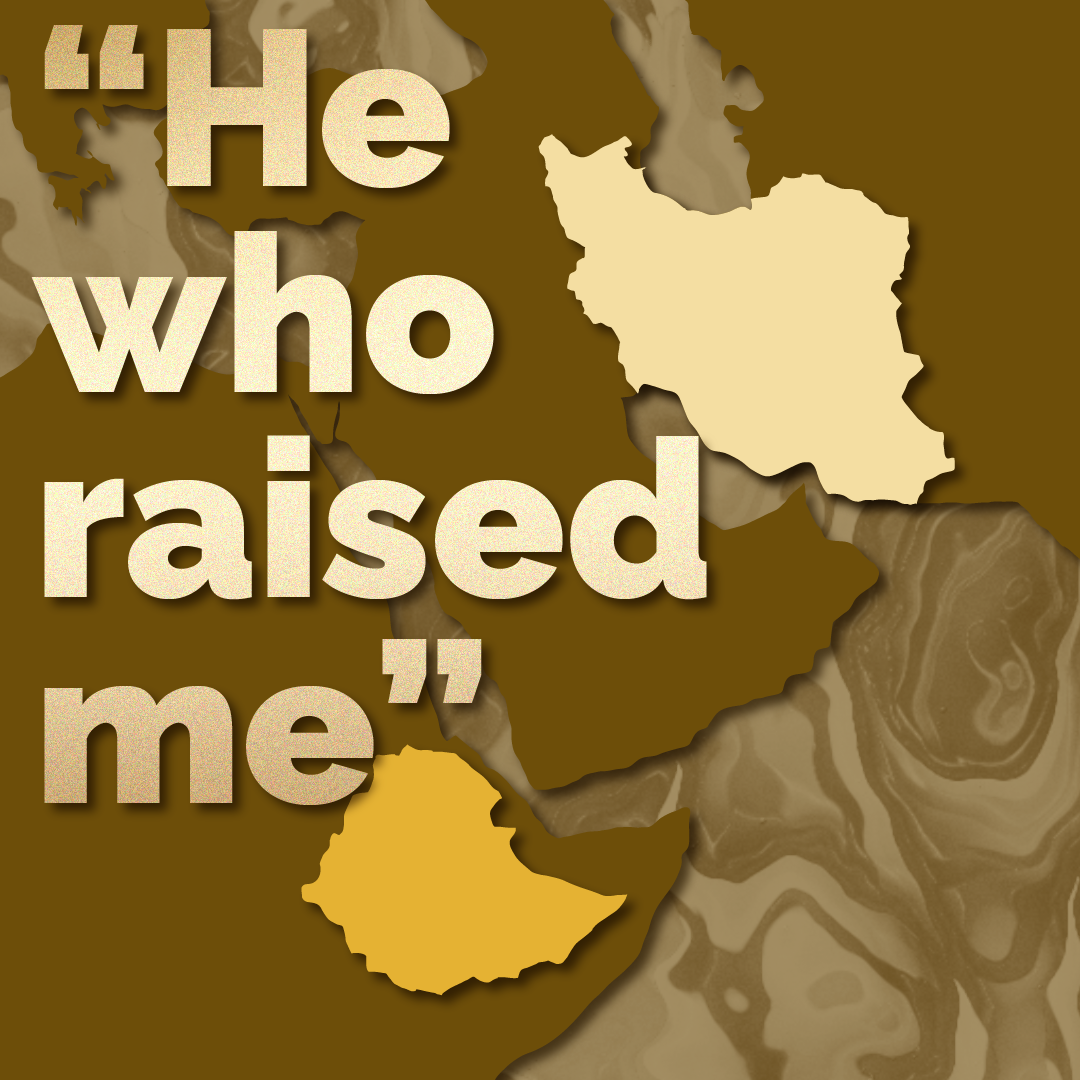
"He who raised Me”: A map homage to Ḥájí Mubárak, whom the Báb later repeatedly referred to as “He who raised me.” Ḥájí Mubárak will appear several times in the pages of this story. He was originally from Ethiopia, at the bottom of the map, and lived his entire life in Persia, at the top of the map. The two countries are connected by the verse from the Báb. © Violetta Zein
In 19th century Persia, every wealthy household, including the family of the Báb, owned domestic slaves. There are two important points to keep in mind.
The first is that the same word can describe opposite social realities depending on the cultural context. As opposed to their counterparts in the Americas, slaves in Muslim countries, including Persia, were servants who were permitted according to their capacities to rise all the way to the top echelons of society, some even becoming Governors and Vizirs.
The second thing to keep in mind is that the servants of the Báb’s family were treated exceptionally well, with generosity and kindness.
This is the story of Ḥájí Mubárak, the mysterious “Ethiopian servant” who appears regularly in Nabíl’s thrilling narrative, the Dawn-Breakers.
Ḥájí Mubárak was born in Ethiopia, and he had been sold into slavery when he was 5 years old. He was transported from his home by slave traders and trained for both domestic work and business in the house of the Báb's relatives.
Ḥájí Mubárak helped raise the Báb, from the age of 7, and so the Báb knew Ḥájí Mubárak for His entire life. One of his specials tasks was to look after the Báb as a child and to train Him in impeccable manners. It is clear that Ḥájí Mubárak became a father figure to the Báb Who placed Mubárak on the same plane as His own father, referring to him in countless prayers as “He who raised me.”
In the Kitáb-i Sá Duá (The Book of Thirty Prayers) revealed in Chihríq, the Báb speaks about Ḥájí Mubárak in exalted terms, and His special love and kindness towards Ḥájí Mubárak is crystal clear in prayer number 7, related to when the Báb was 7 years old. In this prayer, the Báb’s love and tenderness for His African servant is the most powerful message of unity and brotherhood:
“Send down, then, upon me, O my God, when I was seven years old and upon him who raised me on Thy behalf, whose name is Mubárak, that which beseemeth the splendours of the sanctity of Thy loftiness and the wonders of the might of Thy revelation.”
Later in this same prayer, the Báb fondly remembers that Ḥájí Mubárak had made a bow and arrow for Him to play with as a seven-year-old-boy and asks God to bless him for his kindness towards Him:
“…and for the bow and arrow he made for Me to play with at that age, [send him] what is in Thy knowledge of Thy grace and mercy.”
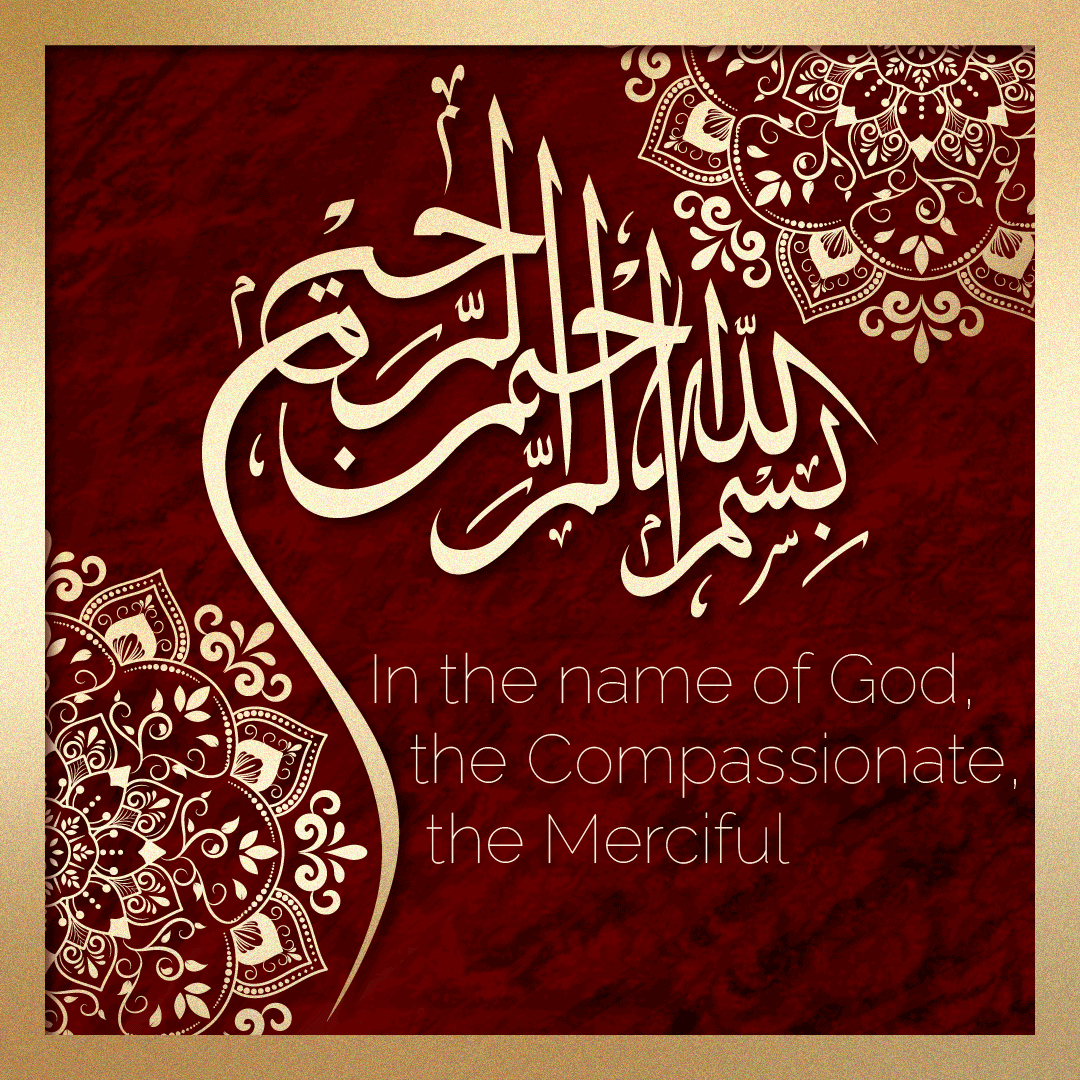
“Bismi’lláh”: A calligraphy of the opening verse of the Qur’án, “Bismi’lláhi’r-Raḥmáni’r-Raḥím (In the name of God, the Compassionate, the Merciful)”the subject of the vignette blow. © Violetta Zein
Shaykh 'Ábid, the Báb’s teacher, was very pious and learned man, a disciple of both Shaykh Aḥmad and Siyyid Káẓim. One day, he asked the Báb to recite the opening words of the Qur’án which begin with “Bismi’lláhi’r-Raḥmáni’r-Raḥím (In the name of God, the Compassionate, the Merciful).”
At first, the Báb hesitated, stating that, unless He were told what the words meant, He would not recite them. His teacher feigned ignorance, and the Báb offered to give their meaning. He proceeded to expound on the meanings of the words Alláh (God), Raḥmán (the Compassionate), and Raḥím (the Merciful). His explanations were so fluent and knowledgeable, so novel, that His teacher felt compelled to take the Báb back to His uncle’s home.
Shaykh 'Ábid found Ḥájí Mírzá Siyyid 'Alí alone in his office and explained how unworthy he felt of teaching such a remarkable child:
“I have brought Him back to you and commit Him to your vigilant protection. He is not to be treated as a mere child, for in Him I can already discern evidences of that mysterious power which the Revelation of the Ṣáḥibu’z-Zamán [the Lord of the Age, one of the titles of the promised Qá'im] alone can reveal. It is incumbent upon you to surround Him with your most loving care. Keep Him in your house, for He, verily, stands in no need of teachers such as I.”
Ḥájí Mírzá Siyyid 'Alí sternly rebuked his Nephew:
“Have You forgotten my instructions? Have I not already admonished You to follow the example of Your fellow-pupils, to observe silence, and to listen attentively to every word spoken by Your teacher?”
The Báb promised to obey His uncle faithfully and returned to school. But the soul of the Báb was incandescent. No amount of admonitions or discipline could repress His innate knowledge, and day after day, He continued to manifest His remarkable intellect. His superhuman wisdom continued to render His teachers speechless.
The sweetness of the Báb’s utterances, so many years ago, on ‘Alláh, Raḥmán, and Raḥím, would linger for a long time in the mind of Shaykh 'Ábid.
It said that Shaykh 'Ábid once told ‘the Báb’s uncle:
"If you pay school fees to me, it is a present! I can teach him nothing! His explanations of difficult passages in the Qur'an are marvelous! His answers to complex problems are amazing!"
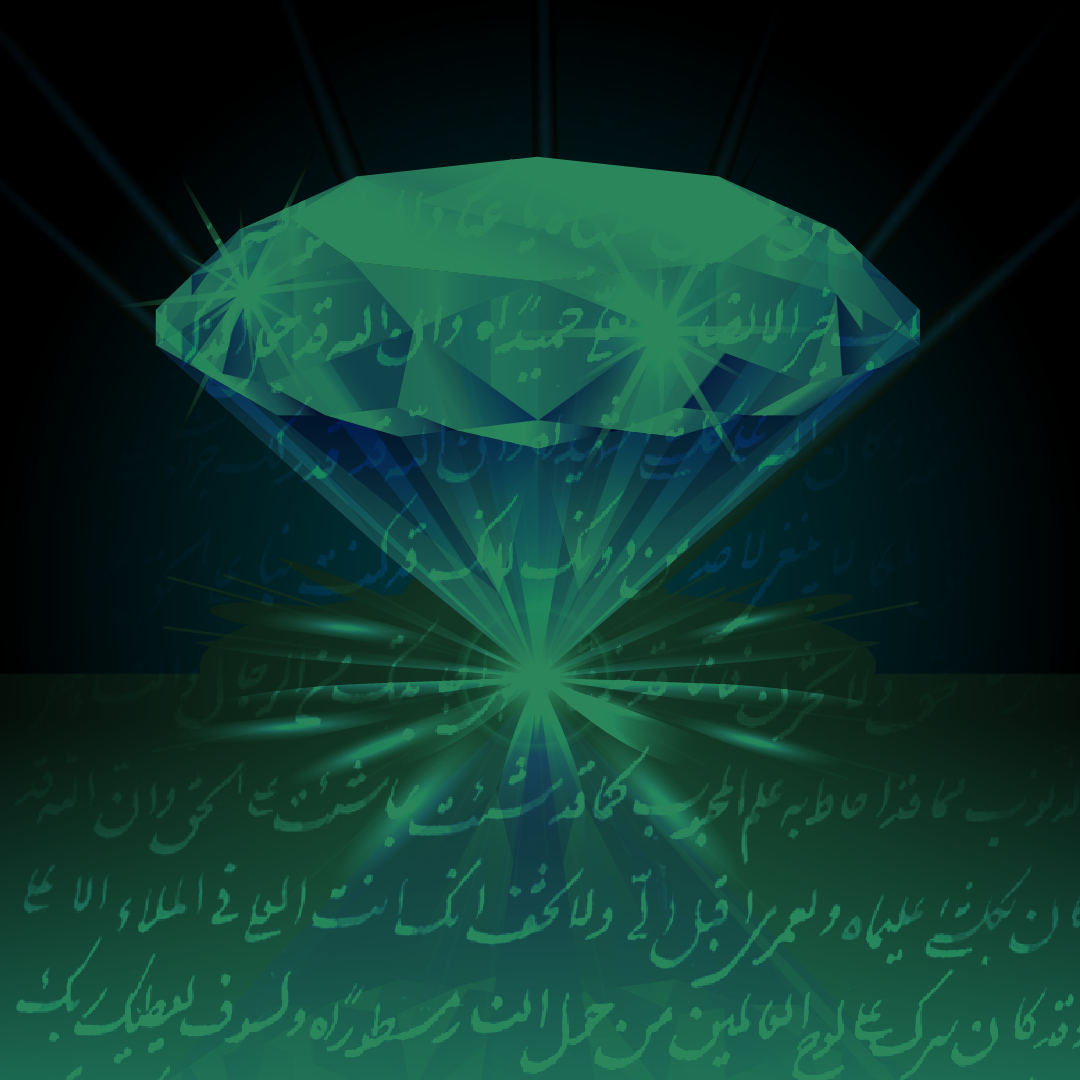
“Mesmerizing child”: An artistic interpretation of the Manifestation of God as a child, showing obvious signs of His coming Revelation and regenerating message to the world. Background verses from the Qayyúmu'l-Asmá' at the British Library. © Violetta Zein
Ḥájí Siyyid Javád was one of the most well-respected mullás of Karbilá as well as a cousin of the Báb’s father. One night, he was visiting the family and stayed overnight as a guest of the Báb’s uncle, at his home in Shíráz, when the Báb was around 7 or 8 years old. Upon arriving that night, Siyyid Javád’s interest was piqued when he noticed the beautiful character of the Báb.
Very early the next morning, before dawn, Siyyid Javád heard the sweet little voice of a child chanting in the prayer room, next to where he was sleeping. This highly influential divine became so utterly enraptured by the sweetness of the voice, the beauty of the prayers, the ardency of the devotion, that he almost opened the door to his room to find out who it was. But he waited until dawn when Ḥájí Mírzá Siyyid ‘Alí, the Báb’s uncle came to meet him, and he saw the Báb again.
The same wondrous child that had impressed him the night before was the very same one who had so moved him with his chanting. As soon as his eyes fell on the Boy, he saw such an illumination, an expression on his face that was so indescribably beautiful that a thought crossed the Siyyid’s mind:
“I felt I could not find throughout the whole human race one like him.”
Before he could ask his host who the child was, Ḥájí Siyyid ‘Alí said:
“This is my sister’s child.”
Over breakfast, Siyyid Javád asked the Báb a few simple questions, and was struck by how the child answered him, in the deep, serious manner of a highly educated adult. After some time, the Báb announced He was leaving for school, and Siyyid Javád was so drawn to Him that he followed the Báb to Shaykh 'Ábid’s.
At first, Shaykh 'Ábid was surprised to see a scholar of Siyyid Javád’s caliber come to his house unannounced, but the Siyyid immediately clarified the situation, pointing to the Báb:
"I have not come to see you. I followed this little child."
He turned to the Shaykh and asked:
"What do you think of this boy?"
The Shaykh instantly replied in a voice filled with emotion:
"What are you asking me? This child seems to me to be ready to proclaim, to give out a message to the world. What can I say about this child! You see that this child comes to my school as a pupil, but in reality he is my teacher and I am his pupil. During classtime he says so many wonderful things and goes into so many deep and important questions that I have never heard anything like it in all my life. When the children go out to play one sees him sitting there, reading most important writings. If the children come and insist that he go and play with them he goes and engages them in a way which they do not understand; then he slips away and returns to his work."
Siyyid Javád returned to Ḥájí Mírzá Siyyid ‘Alí’s home. His admiration and wonder at Ḥájí Mírzá Siyyid ‘Alí’s extraordinary nephew had greatly increased after he witnessed first-hand Shaykh 'Ábid’s admiration of his young Student.
He recounted his interaction with the Báb’s teacher in great detail and Ḥájí Mírzá Siyyid ‘Alí answered:
"I hear so much about this boy. Yet, if *I* told anything people would only say, 'He likes to speak well of his nephew.'”

Calligraphic exercise of the Báb written before He was ten years old. Source: Baha'i Sacred Relics.
On another of Siyyid Javáds-i-Karbilá’ís visits, he was present when the Báb returned from school, and he noticed the Child was carrying a batch of papers.
Curious, he asked the Báb what they were and very courteously, the Báb responded they were His calligraphic exercises.
When Ḥájí Siyyid Javád inspected them, he marveled at their excellence.
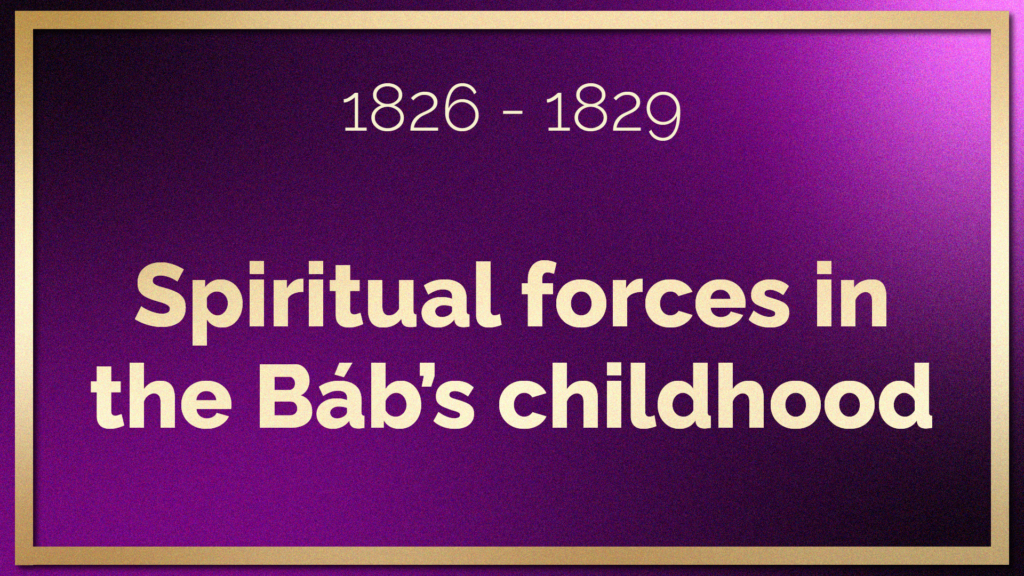
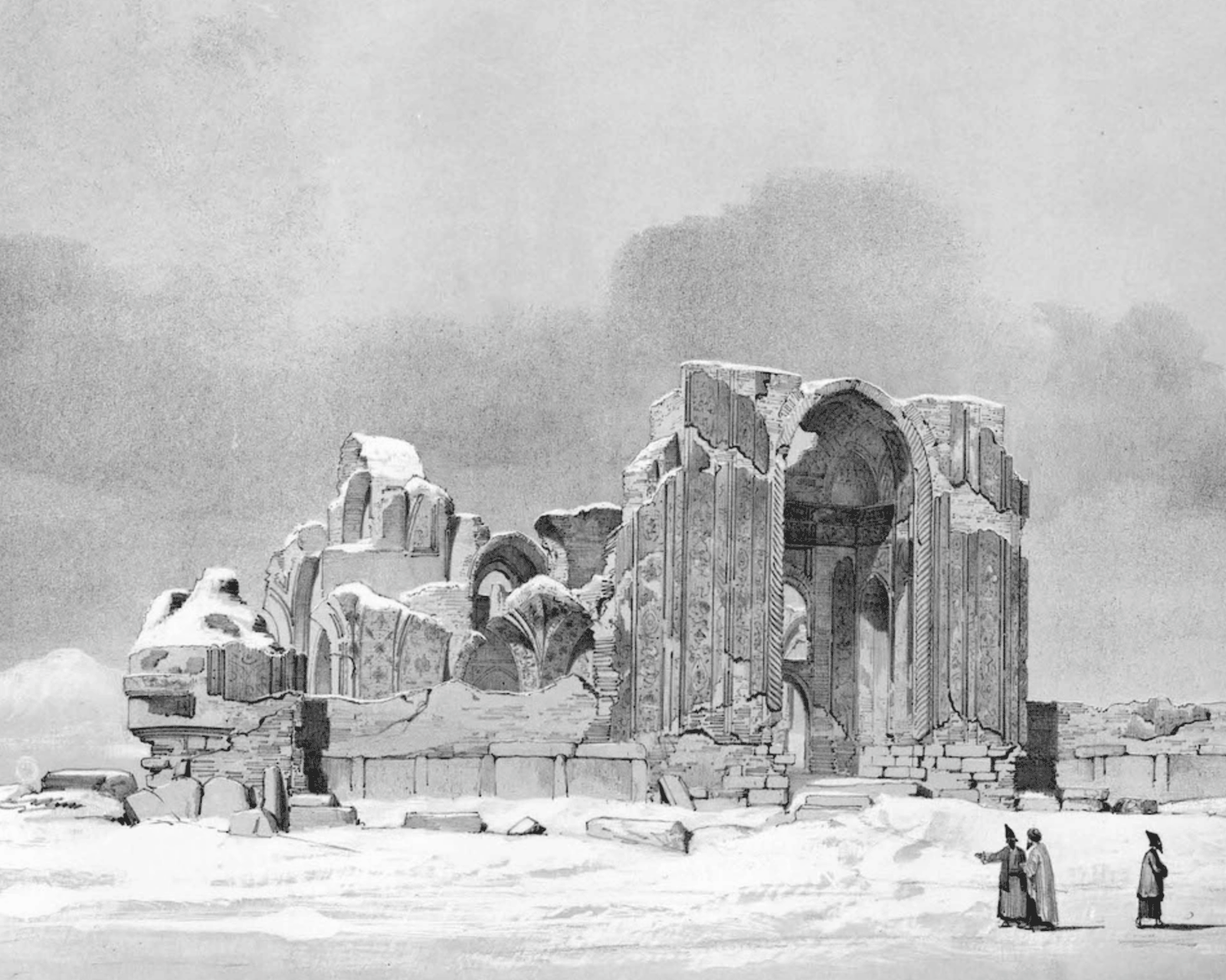
An engraving of the devastating 8 January 1780 earthquake in Tabríz. Source: 24/7 Wall Street.
From His earliest childhood, the Báb exhibited proofs of His stainless character, and evidences of divine qualities and powers of omniscience, the same qualities that would later convince His first disciples, the Letters of the Living, to joyfully and willingly forego their lives, wealth, fame, status, wives and children to follow Him.
As a child, signs of the Báb's holiness, majesty, and lofty rank were abundantly apparent: He knew with certainty if a pregnant woman was carrying a boy or a girl, and he foretold random events, such as earthquakes.
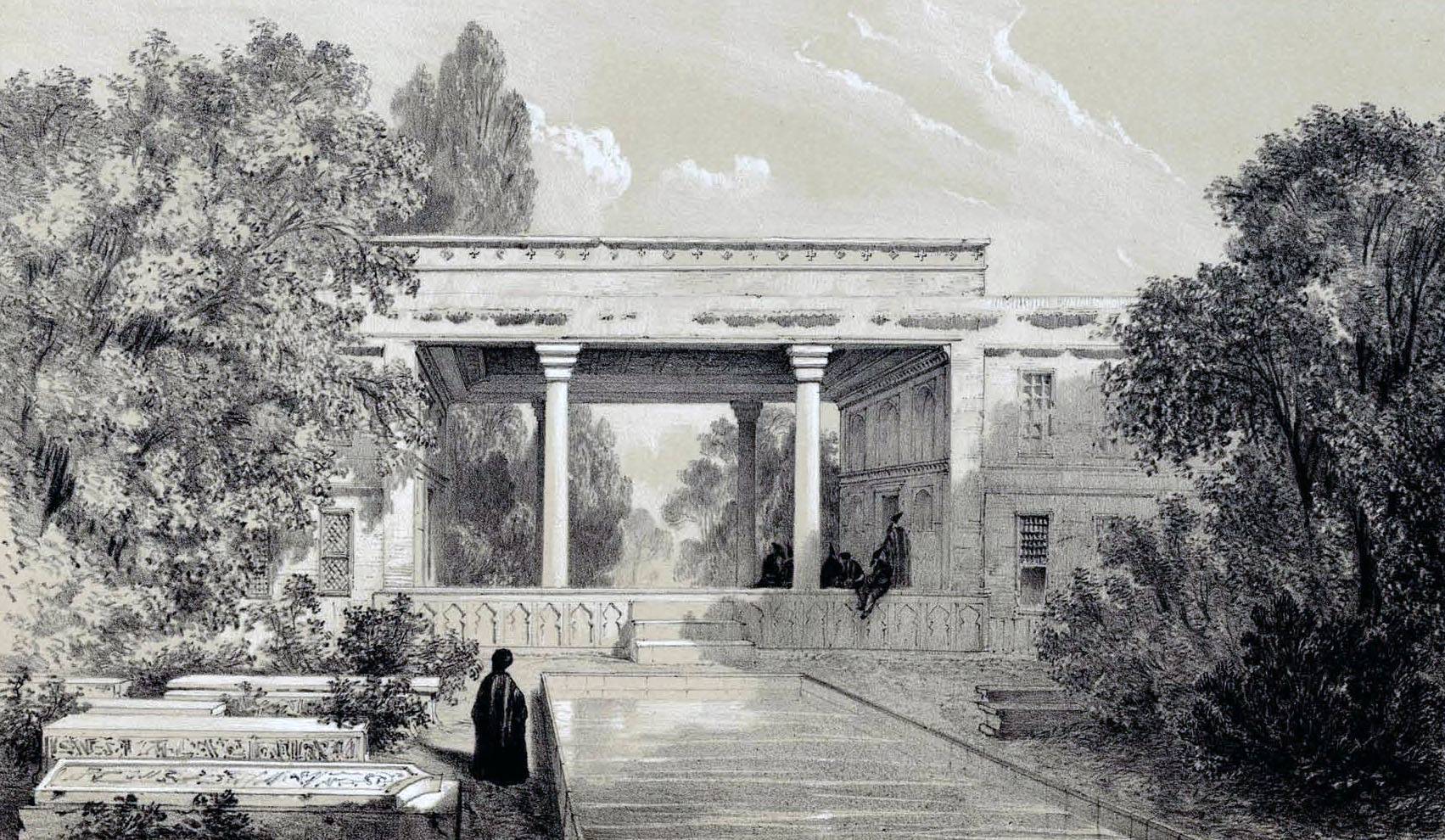
The tomb of Ḥáfiẓ in Shíráz. In the story below, the Báb quotes a couplet by Ḥáfiẓ. Engraving by Eugène Flandin, 1840s, from Voyage en Perse, avec Flandin, éd. Gide et Baudry. Source: Wikimedia Commons.
During the entirety of His schooling, the Báb’s mental faculties and depth of knowledge kept Shaykh 'Ábid wonderstruck. Apart from teaching boys of the Báb’s age, the Shaykh also held separate classes for older theological students which his young pupils did not attend.
One day, a seminary student asked a particularly difficult question which remained unanswered after a long period of discussion. Shaykh 'Ábid told the students he would consult authoritative works that night and return with the answer the next morning.
Just then, the Báb, who had been listening, spoke up and resolved the question with sound reasoning. The teacher and students were astonished, as they had never discussed this subject within earshot of the Báb.
Shaykh 'Ábid asked Him where He had obtained that knowledge, and the Báb quoted a couplet from Ḥáfiẓ, with a smile:
“Should the grace of the Holy Spirit once again deign to assist,
Others will also do what Christ could perform.”
This response from the Báb indicates clearly that, like Bahá'u'lláh, He felt the stirrings of prophethood in His youth.
There was clearly another side to the mental and spiritual faculties of the Báb. His family noticed that the Báb would sometimes be sad or happy as He was immersed in rapture, and deeply connected to an unseen, spiritual world.
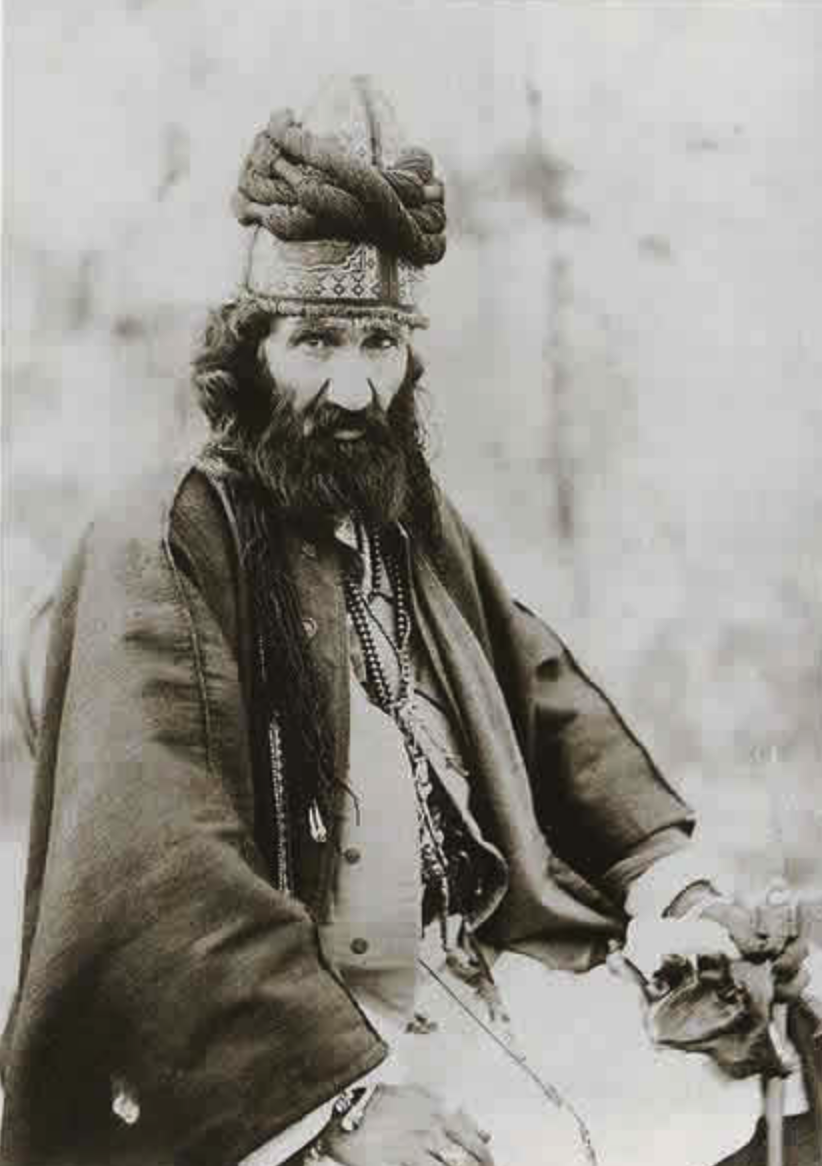
In lieu of an engraving or photograph of a soothsayer, a late 19th century photograph of a dervish in Persia by Antoin Sevrugin. Source: Wikimedia Commons.
There were so many unexplainable miracles, extraordinary things about the Báb as a child, that His youngest maternal uncle, Ḥájí Mírzá Ḥasan ‘Alí suggested the Child might be under the spell of jinn or fairies and that the family should seek the help of a competent practitioner and request protective prayers for Him.
An astrologer, Áqá Muḥammad-Ḥasan was brought to the house and apprised of the details surrounding the Báb. After making some calculations, the astrologer pronounced:
“He is protected from the malevolence of jinn and fairies, and he has not suffered any harm from sprites.”
The astrologer then asked for the Báb’s birthdate. After obtaining the information, he wrote down protective charms and prayers and gave them to the family, recited some mysterious verses and left.
Once the astrologer had left, the Báb tore up his talismans, charms, prayers, writings, and the instruction sheet he had left for the family, tossed them out and said:
“In the words of the mystic: You make a great show of assistance, but I am that assistance.”
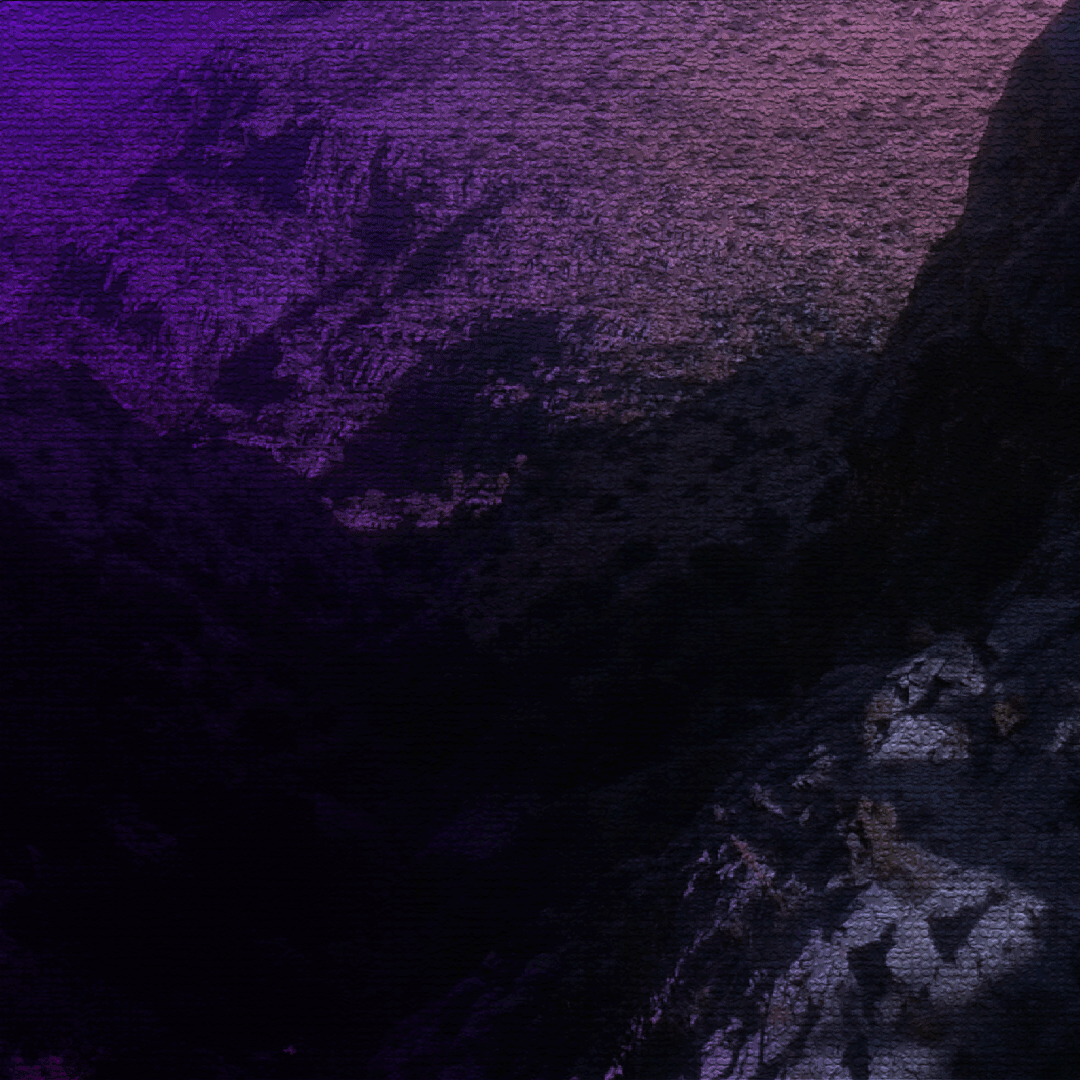
“Night prayer”: An artistic interpretation of the night prayer of the Báb, in the steep rockface of mountains south of Shíráz. © Violetta Zein
In the mountains 12 kilometers (7.5 miles) to the south of Shíráz, lies the shrine of Sabz-Púshán. It is a difficult journey to the shrine, exhausting even to the strong and healthy traveler.
When the Báb was around 9 years old, His uncles took Him to Sabz-Púshán with their group, and everyone was completely exhausted when they arrived. They performed their ablutions, performed their afternoon and evening obligatory prayers, paid homage to the shrine, had dinner and went to bed.
Not long after going to bed, at midnight, the Báb’s uncle Ḥájí Mírzá Siyyid ‘Alí, awoke and noticed the Báb was not in bed. Worried and anxious that His Nephew might have fallen off the mountain, he searched everywhere until finally he heard a voice chanting prayers glorifying and praising God rising from below him on the mountain.
As he followed the melody, he found the Báb, standing alone in a secluded, private area, in all-consuming rapture, voicing prayers and supplications to His beloved Lord, on a deserted mountainside, in the middle of the night.
This event would stay with Ḥájí Mírzá Siyyid ‘Alí for decades.
When the Báb made His Declaration, Ḥájí Mírzá Siyyid ‘Alí believed in Him with absolute certainty. He would be the first Bábí in Shíráz after the Letters of the Living and the only member of the Báb’s family apart from the Báb’s wife Khadíjih Bagum, to espouse His Faith openly during the Báb’s lifetime.
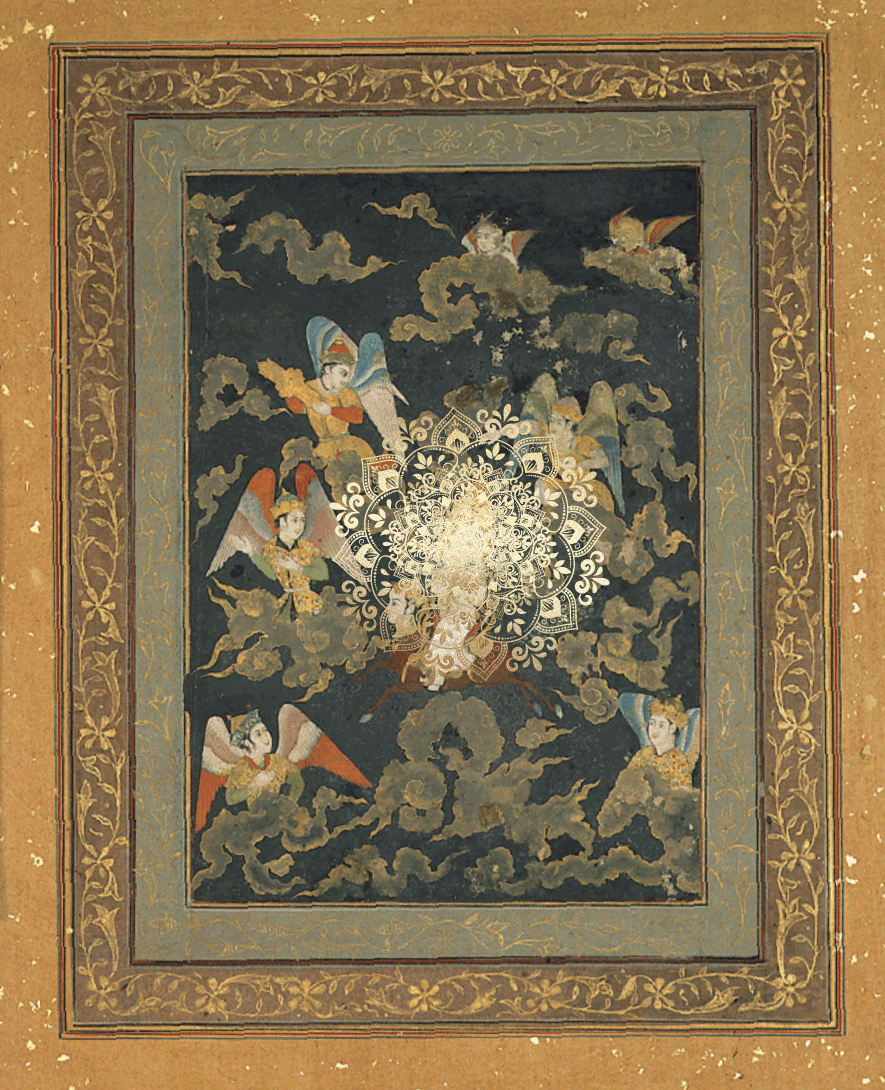
Late 17th century painting of the Prophet Muḥammad’s ascent to heaven (the Mi'raj). The Báb in the story below wishes to be like His Ancestor, Whom He calls His Grandfather. The Báb was the next Manifestation of God after the Prophet Muḥammad. The Prophet Muḥammad has been concealed, out of respect. Source: Wikimedia Commons.
Beyond His superior knowledge and abilities, the Báb impressed Shaykh 'Ábid with the nobility of His character.
All those who interacted with the Báb in His childhood and youth were thrilled by His beauty, His charm, and His devotion. The Báb was always dignified and serene, and He had no interest in the hobbies of other boys His age. From a very young age, the Báb had a contemplative nature and preferred silence. He also showed an abiding interest in theological questions from childhood.
Some mornings, the Báb arrived to school late but would remain silent when asked for the reason. Whenever the teacher sent His fellow-pupils to fetch Him from home, they invariably found Him deep in prayer.
On one of these days, Shaykh 'Ábid asked the Báb about His lateness and the boy replied quietly that he had been in the house of His “Grandfather,” a term Siyyids like the Báb, directly descended from the Prophet Muḥammad, use to designate their Ancestor.
Shaykh 'Ábid reached out to the boy, telling Him He was only a child of 10 and such rigorous, pious devotions were not required of Him. The Báb responded:
“I wish to be like My Grandfather.”
The Báb’s deep devotion and piety was a constant throughout His childhood and youth.
It was customary on Fridays, when the weather was good, for the boys to invite their teachers for an outing in one of the many gardens bordering Shíráz.
On these outings, the school children would often find the Báb had retired to a shaded, secluded spot in a corner of the orchard to pray and meditate.
Visitors to the home of the Báb would remember for decades the sound of the Báb’s chanting prayers in a melodious, enraptured voice, rising from the alcove of the prayer room.
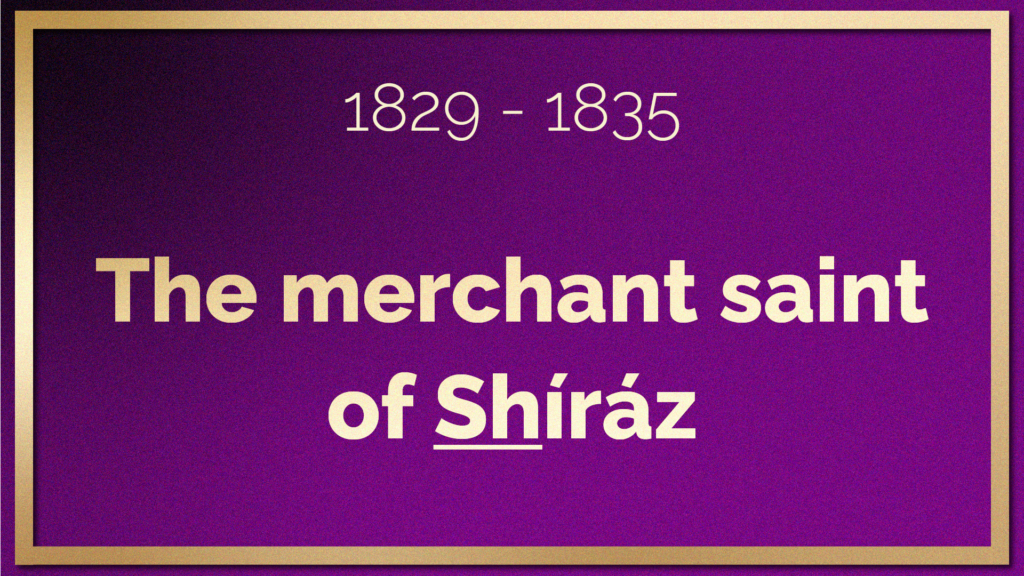
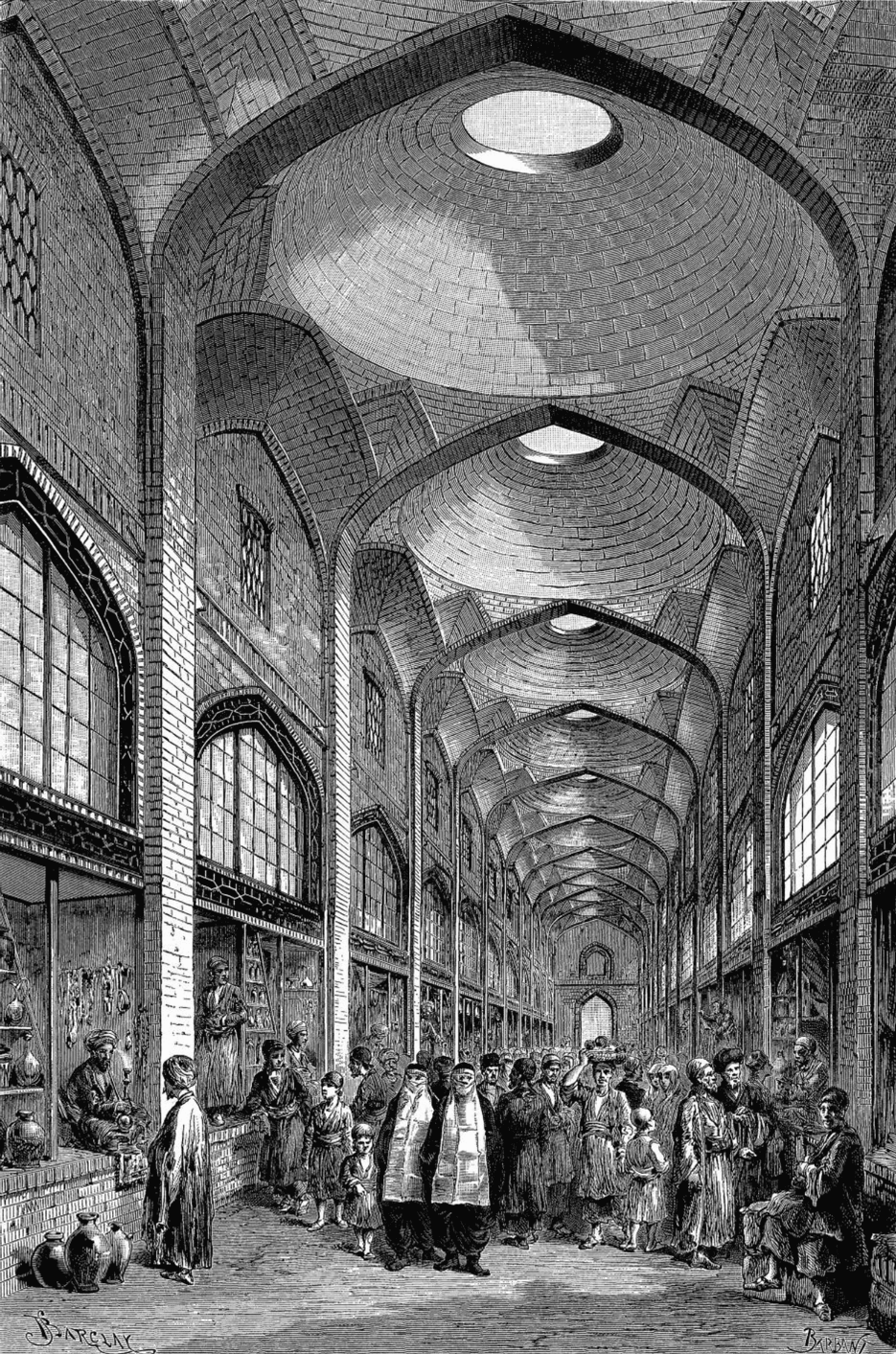
The Vakil Bazar in Shíráz from Jane Dieulafoy, La Perse, la Chaldée et la Susiane, page 451. Source : Archive.org.
Ḥájí Mírzá Siyyid ‘Alí took his Nephew out of school when He turned 10, despite the protestations of Shaykh 'Ábid.
Between the age of 10 and 15, the Báb began learning the family trade, spending long hours in the bazaar in Shíráz, but not engaging in trade yet. From this time, we have archives of commercial accounts in the handwriting of the Báb.
The Báb dutifully helped His uncle with His work, and spent the rest of His time in meditation on the Holy Books. He had a gentle and loving character, and was loved by everyone.
People called the Báb “heavenly,” and this is how He was described in His teenage years:
“this youth who walks with the dignified and serene step, who is of so shining a countenance, and withal so beautiful, and, moreover, greatly learned in the Sacred Writings."
When He was 15, the Báb left Shíráz for Búshihr to become a merchant.
REFERENCES FOR PART I
20 October 1819: The birth of the Báb
Baharieh Rouhieh Ma’ani, Leaves of the Twin Divine Trees, pages 3-4.
Nabíl, The Dawn-Breakers, pages 75-76.
Appendix 2 from “In the Land of Refuge” by Ḥájí Mírzá Ḥabibu’lláh Afnán (Early to mid 1930s), cited in Childhood of the Báb, compiled by David Merrick.
H.M. Balyuzi, The Báb: The Herald of the Day of Days, page 32.
Wikipedia: Husayn ibn Ali.
The Primal Point: The station of the Báb
Shoghi Effendi, God Passes By and excerpt 2.
Shoghi Effendi, The Golden Age of the Cause of Bahá’u’lláh: The Station of the Báb.
Bahá’u’lláh, The Kitáb-i-Íqán.
The Báb: Fulfillment of prophecies
Shoghi Effendi, God Passes By.
1819 – 1821: A serene and quiet infant
“In the Land of Refuge” by Ḥájí Mírzá Ḥabibu’lláh Afnán (Early to mid 1930s), cited in Childhood of the Báb, compiled by David Merrick.
1824: The bathhouse roof collapses
“In the Land of Refuge” by Ḥájí Mírzá Ḥabibu’lláh Afnán (Early to mid 1930s), cited in Childhood of the Báb, compiled by David Merrick.
Mírzá Habibu’llah Afnan (Translated and annotated by Ahang Rabbani), The Genesis of the Bahá’í and Bábí Faiths in Shíráz and Fárs (Translation of Táríkh Amrí Fárs Va Shíráz), published in Numen Book Series: Studies in the History of Religions (Texts and Sources in the History of Religions) Volume 122, BRILL (2008), page 6.
1824: A childhood dream of the Báb
“In the Land of Refuge” by Ḥájí Mírzá Ḥabibu’lláh Afnán (Early to mid 1930s), cited in Childhood of the Báb, compiled by David Merrick.
Around 1824: The Báb’s father marvels at His son
Lambden, Stephen, An Episode in the Childhood of the Bab, published in In Iran: Studies in Babi and Bahá’í History vol. 3, ed. Peter Smith, pages 1-32 Los Angeles: Kalimat Press, 1986.
“In the Land of Refuge” by Ḥájí Mírzá Ḥabibu’lláh Afnán (Early to mid 1930s), cited in Childhood of the Báb, compiled by David Merrick.
Mírzá Habibu’llah Afnan (Translated and annotated by Ahang Rabbani), The Genesis of the Bahá’í and Bábí Faiths in Shíráz and Fárs (Translation of Táríkh Amrí Fárs Va Shíráz), published in Numen Book Series: Studies in the History of Religions (Texts and Sources in the History of Religions) Volume 122, BRILL (2008), page 6.
1824: The Báb meets his future teacher for the first time
“In the Land of Refuge” by Ḥájí Mírzá Ḥabibu’lláh Afnán (Early to mid 1930s), cited in Childhood of the Báb, compiled by David Merrick.
Mírzá Habibu’llah Afnan (Translated and annotated by Ahang Rabbani), The Genesis of the Bahá’í and Bábí Faiths in Shíráz and Fárs (Translation of Táríkh Amrí Fárs Va Shíráz), published in Numen Book Series: Studies in the History of Religions (Texts and Sources in the History of Religions) Volume 122, BRILL (2008), page 5.
Fereydun Vahman (Editor),The Bab and the Babi Community of Iran (2020), Chapter 1: The Báb: A Sun in a Night Not Followed by Dawn by Fereydun Vahman.
1824: The Báb’s first day at school
Lambden, Stephen, An Episode in the Childhood of the Bab, published in In Iran: Studies in Babi and Bahá’í History vol. 3, ed. Peter Smith, pages 1-32 Los Angeles: Kalimat Press, 1986.
Balyuzi, H.M., The Báb: Herald of the Day of Days, pages 34-35.
Terry, Peter (translator and editor), A Prophet In Modern Times by A.L.M. Nicolas. Volume I of the Babi Studies Series, (2008), page 20.
Tarikh-i-Jadid pages 261-264 (1880) cited in Childhood of the Báb, compiled by David Merrick.
After 1824: “I could fly up beyond the Throne”
Tarikh-i-Jadid pages 261-264 (1880) cited in Childhood of the Báb, compiled by David Merrick.
Wikipedia: Throne of God.
Fetullah Gülen: The ‘Arsh (The Supreme Throne of God).
Lady Blomfield, The Chosen Highway, Chapter 1: The Báb.
1826: The Báb’s father passes away
Baharieh Rouhani Ma’ani, Leaves of the Twin Divine Trees, pages 3-6 and 26-27.
Abbas Amanat, Resurrection and Renewal: The Making of the Bábí Movement in Iran (1844-1850), pages 110-111.
HOW THE DATE WAS DETERMINED
Abbas Amanat is perhaps the most knowledgeable Bahá’í historian about Qajár Iran. He has determined that the Báb’s father passed away at the age of 49, and below is the note from his masterful Ph.D. thesis, Resurrection and Renewal, in full:
“The age of Sayyid Muḥammad Rizá could be worked out from Mullá Fatḥulláh Khádim’s account cited in Mírzá Ḥabibulláh Táríkh 4, 9. What Mu’ín (30) and Guláyigání (Táríkh-i-Ẓuhúr, 3) say about his death at an earlier time is incorrect. The Báb himself does not refer in his writings to his father’s death. For the outbreak of cholera in the 1820s and 1830s in southern Iran, see J. G. Lorimer Gazetteer of the Persian Gulf, Oman and Central Arabia 2 vols (Calcutta, 1905) I, part 2, app. M, 2517-2662 and H. Náṭiq Muṣíbat-i- Vabá 12-16.”
1829: “I wish to be like My Grandfather”
Balyuzi, H.M., The Báb: Herald of the Day of Days, pages 35-37.
Terry, Peter (translator and editor), A Prophet In Modern Times by A.L.M. Nicolas. Volume I of the Babi Studies Series, (2008), page 19.
1826: Ḥájí Mubárak: “Him who raised me”
Wikipedia: Slavery in Iran.
Nader Saedi, The Ethiopian King, translated by Omid Ghaemmaghami published in Baha’i Studies Review, Volume 17.
Anthony A. Lee, The Baha’i Faith in Africa: Establishing a New Religious Movement (1952–1962), pages 21-22.
Abu’l-Qasim Afnán, Black Pearls: Servants in the Households of the Báb and Bahá’u’lláh.
Anthony Lee, Recovering the Lives of Enslaved Africans in Nineteenth-Century Iran: A First Attempt, published in Changing Horizons in African History, Africa World Press, 2016.
After 1826: “I have brought Him back to you”
Nabíl, The Dawn-Breakers, pages 75-76.
Lady Blomfield, The Chosen Highway, Chapter 1: The Báb.
Tarikh-i-Jadid pages 261-264 (1880) cited in Childhood of the Báb, compiled by David Merrick.
The Life of the Báb from Jináb-i-Faḍil (Star of the West, Set 7, Volume 14, Number 7, page 193), cited in Childhood of the Báb, compiled by David Merrick.
Around 1826/1827: An utterly mesmerizing child
“And a Little Child Shall Lead Them: An Incident from the Early Life of the Báb adapted from addresses given in London by Jináb-i-Avárih and published in Star of the West in 1923, cited in Childhood of the Báb, compiled by David Merrick.
After 1826/1827: Calligraphy exercises
H.M. Balyuzi, The Báb: The Herald of the Day of Days, page 37.
Manifestations of omniscience in the Báb’s childhood
Tarikh-i-Jadid pages 261-264 (1880) cited in Childhood of the Báb, compiled by David Merrick.
Balyuzi, H.M., The Báb: Herald of the Day of Days, page 35.
“In the Land of Refuge” by Ḥájí Mírzá Ḥabibu’lláh Afnán (Early to mid 1930s), cited in Childhood of the Báb, compiled by David Merrick.
“In the Land of Refuge” by Ḥájí Mírzá Ḥabibu’lláh Afnán (Early to mid 1930s), cited in Childhood of the Báb, compiled by David Merrick.
“In the Land of Refuge” by Ḥájí Mírzá Ḥabibu’lláh Afnán (Early to mid 1930s), cited in Childhood of the Báb, compiled by David Merrick.
1829: “I wish to be like My Grandfather”
Balyuzi, H.M., The Báb: Herald of the Day of Days, pages 35-37.
Terry, Peter (translator and editor), A Prophet In Modern Times by A.L.M. Nicolas. Volume I of the Babi Studies Series, (2008), page 19.
1829 – 1835: The Báb joins the family business
Balyuzi, H.M., The Báb: Herald of the Day of Days, page 39.
Terry, Peter (translator and editor), A Prophet In Modern Times by A.L.M. Nicolas. Volume I of the Babi Studies Series, (2008), page 18.
Lady Blomfield, The Chosen Highway, Chapter 1: The Báb.
AGE AT WHICH THE BÁB LEFT SCHOOL
Abu’l Qásim Afnán, a member of the family of the Báb and former custodian of the House of the Báb in Shíráz is a historian of the life of the Báb and His family. He suggests, based on having examined extensive family correspondence, that the Báb began to work in His uncle’s office at the age of 10, and it was at the age of 15—the age of maturity in Islamic law—that He moved to Búshihr, something communicated to David Merrick, compiler of “Childhood of the Báb.”
The Báb Himself corroborates this timeline in the Kitáb al-Fihrist (The Book of the Index):
“After My childhood had passed, by the will of God, I began the occupation of commerce as this was decreed by God, and I commenced this from the age of ten.”
SOURCE: “In the Land of Refuge” by Ḥájí Mírzá Ḥabibu’lláh Afnán (Early to mid 1930s), cited in Childhood of the Báb, compiled by David Merrick.
 The Primal Point: The station of the Báb
The Primal Point: The station of the Báb
